HEALTHCARE ELECTRONIC TECHNOLOGY AICDSCALE1 Bluetooth Diagnostic Scale User Manual
Shenzhen Healthcare Electronic Technology Co., Ltd Bluetooth Diagnostic Scale
user manual
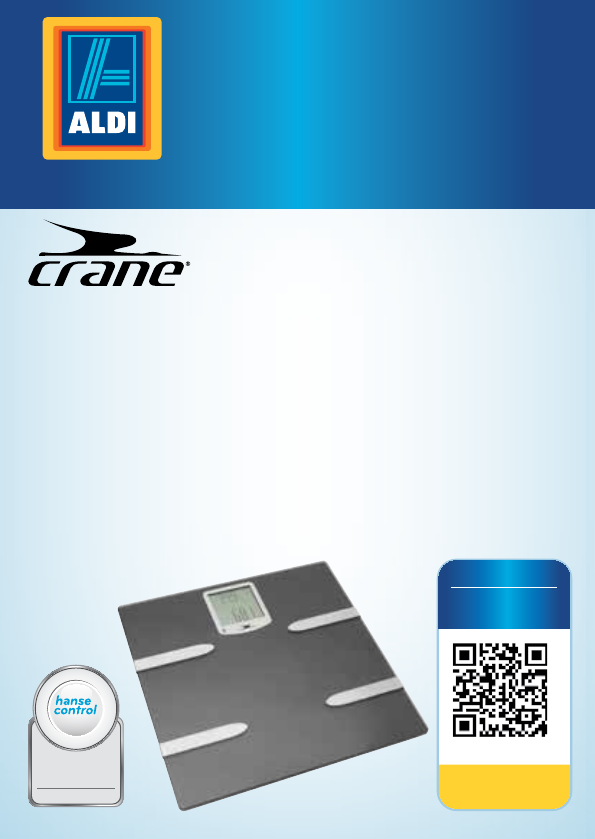
Bluetooth® Diagnostic Scale
Balanza con Diagnóstico por
Bluetooth®
English.....Page 7
Español....Página 45
User Guide
Manual del usario
ID: #05007
m
y
h
a
n
s
e
c
o
n
t
r
o
l
.
c
o
m
M
A
N
U
A
L
D
E
V
E
L
O
P
E
D
I
N
G
E
R
M
A
N
Y
User-friendly
Manual
Product Info
Información
del producto
+ VIDEO
www.aldi.us

QR codes take you where you want to go
quickly and easily
Whether you require product information, spare parts or
accessories, details on warranties or aftersales services, or
if you want to watch a product demonstration video, our QR
codes will take you there in no time at all.
What is a QR code?
A QR code (QR = Quick Response) is a type of matrix that can be
read with a smartphone camera and that contains a link to a
website or contact details, for example.
Advantage: You do not need to manually enter a website ad-
dress or contact details.
This is how it works
To scan the QR code, all you need is a smartphone with QR
code reader software and an internet connection*. This type
of software can be downloaded for free from your app store.
Try it out now
Just scan the QR code with your
smartphone and find out
more about the Aldi product you have
purchased.*
* Depending on your tariff plan you may be
charged for the connection.
Product Info
Información
del producto
+ VIDEO
www.aldi.us

Dok./Rev.-Nr. 92784_20141121
Overview .................................4
Use ............................................5
Scope of delivery/
device parts .............................6
General information ...............7
Reading and storing the
instruction manual ...............7
Explanation of symbols ......8
Safety ....................................... 9
Proper use .............................9
Safety notes .......................... 9
Checking the scale and
product contents .................. 13
Scale and Crane
Connect app .......................... 14
Functions .............................. 14
Measurement method .......15
Compatibility .......................16
Use without app .................. 16
Setup .......................................17
Inserting batteries ..............17
Setting up the scale ............ 18
Affixing the carpet feet ......18
Setting the unit of measure
for weight .............................18
Resetting the
scale memory ......................18
Installing the app ................19
Creating a user account .....19
Handling ................................ 20
Establishing a Bluetooth®
connection .......................... 20
Setting the level of
activity ................................. 22
Performing a
measurement ..................... 23
Contents
Evaluating the
measurements ......................25
Restrictions ......................... 25
Body mass index (BMI) ...... 26
Body fat percentage ......... 27
Body water percentage ....28
Muscle percentage ............30
Bone mass ............................31
Basal metabolic rate
(BMR) .................................... 32
Active metabolic rate
(AMR) .................................... 32
Measurements in relation
to one another ....................33
Cleaning and maintenance ..35
Cleaning .............................. 35
Changing the batteries.....36
Storage ..................................36
Troubleshooting ...................37
Technical data .......................42
Declaration of conformity ....43
Disposal .................................44
Disposing of the
packaging ...........................44
Disposing of old
appliances ........................... 44
Warranty ................................ 91
Warranty Card ......................91
Warranty conditions ..........92
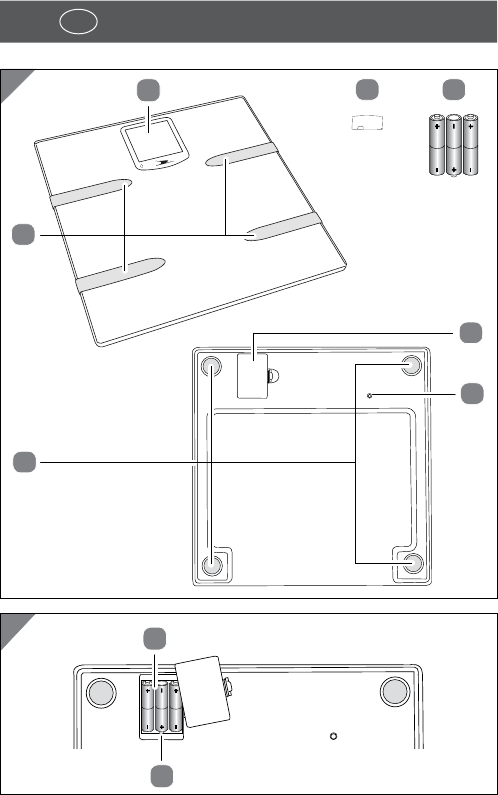
A23
5
1
4
6
7
3
4
B
4Overview • Conjunto
USA
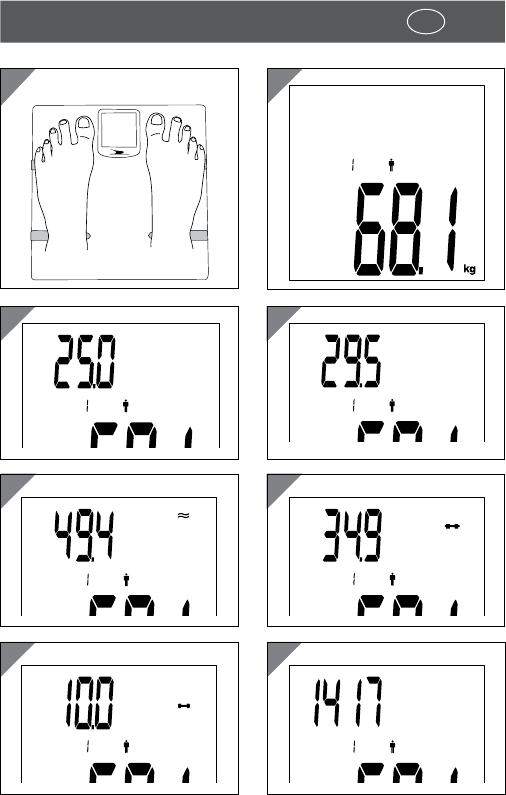
E
G
D
F
H
I J
C
%
User
User
BF
%
User
User
%
User
User
BMR
kcal
User
User
kg
User
User
BMI
User
User
User
User
5
Use • Uso USA

6Scope of delivery/device parts •
Volumen de suministro/partes del aparato
Scope of delivery⁄device parts
1Display
2Carpet feet, 4x
3Batteries, 3x
4Battery compartment
5Reset button
6Support feet
7Measurement electrodes
Volumen de suministro/
partes del aparato
1Display
2Bases para moquetas, 4x
3Pilas, 3x
4Compartimento de pilas
5Tecla Reset
6Patas
7Electrodos de medición
USA
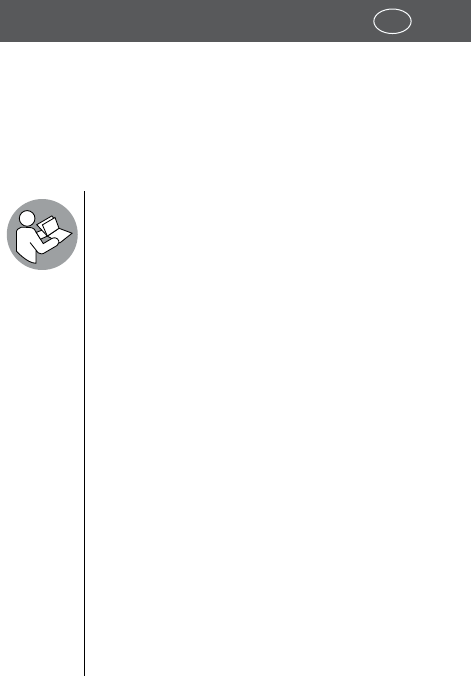
7General information USA
General information
General information
Reading and storing the instruction
manual
This instruction manual accompanies this
Bluetooth® diagnostic scale. It contains im-
portant information on setup and handling.
For improved readability, the Bluetooth®
diagnostic scale will be referred to below
merely as the “scale”.
Carefully read through the instruction
manual, particularly the safety instructions,
before you use the scale. Failure to comply
with the instruction manual may result in
damage to the scale.
This instruction manual is based on the
standards and rules in force in the European
Union. When abroad, you must also observe
country-specific guidelines and laws.
Store the instruction manual for further use.
If you pass the scale on third parties, please
be absolutely sure to include this instruction
manual.
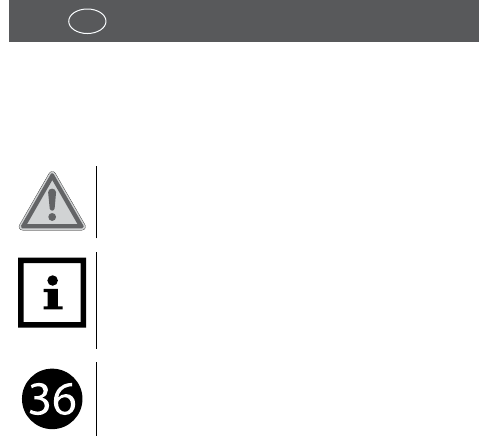
8 General information
USA
Explanation of symbols
The following symbols and signal words are used in this
instruction manual, on the scale or on the packaging.
WARNING! This signal word designates a
hazard with moderate risk, which may re-
sult in death or severe injury if not avoided.
NOTICE! This signal word warns against pos-
sible damage to property or provides you
with useful additional information on han-
dling the product.
This symbol indicates that the warranty for
the scale amounts to 36 months (3 years).

9Safety USA
Safety
Proper use
The scale is designed exclusively for use as an aid for
measuring and displaying your physiological data. The
scale is exclusively intended for private use and is not
suitable for commercial or clinical use. The scale is not a
medical device and is not a toy.
Only use the scale as described in this instruction manu-
al. Any other use is deemed improper and may result in
injury to persons or damage to the scale.
The manufacturer or vendor cannot be held liable for
damages incurred through improper or incorrect use.
Safety notes
WARNING!
Risk of injury!
Failure to use the scale properly
poses a substantial risk of injury.
− Do not use the scale if you rely on med-
ical implants (e.g. a pacemaker). The
voltage used for measurements in the
bioelectric impedance analysis of the
scale may interfere with the functions of
such implants.
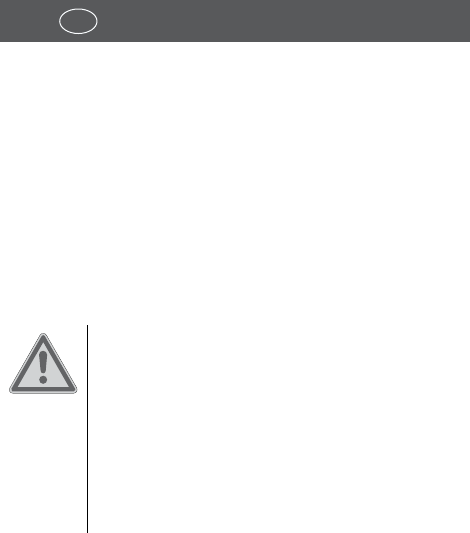
10 Safety
USA
− Do not use the scale if you are pregnant.
− Do not stand on the outer edge of one
side of the scale.
− Do not stand on the scale if your feet are
wet or if you have applied cream to them.
− Dry off the surface of the scale before
you use it.
− Discontinue using the scale if it exhibits
visible damages.
WARNING!
Risks associated with using
batteries!
The scale is battery-operated. Im-
proper handling of the batteries
may result in injury and damage
to property.
− Store the batteries in an area that is not
accessible for children. If you suspect that
a child has swallowed a battery, immedi-
ately contact a physician.
− Never expose the batteries to excessive
heat such as direct sunlight, open flames
orsimilar.

11Safety USA
− Do not charge the batteries or reactivate
them with other means.
− Do not short circuit the batteries.
− Do not open the batteries.
− To prevent the batteries from leaking,
only insert batteries of the same type in
the scale.
− Promptly remove empty batteries from
the scale.
− Do not allow battery acid to come into
contact with skin, eyes or mucus mem-
branes. In the event of contact with bat-
tery acid, immediately flush the applica-
ble areas with plenty of clean water and
consult a physician if necessary.
− If batteries in the scale leak, use gloves
to remove them. Afterwards, clean the
battery compartment with a cloth with-
out
water or any cleaners.
− If you do not use the scale for a pro-
longed period, remove the batteries
from the battery compartment.

12 Safety
USA
NOTICE!
Risk of damage!
Improper use of the scale may
damage it.
− Do not expose the scale to strong mag-
netic fields (e.g. transformers). Oth-
erwise this could cause errors in data
transmission or damage to the scale.
− Do not open the scale.
− Do not immerse the scale in water and
do not rinse it off under running water.
− Protect the scale against impacts and
chemicals.
− Do not expose the scale to extreme tem-
perature fluctuations.
− Do not set up the scale near strong heat
sources (e.g. ovens or radiators).
− Do not place any objects on the scale
when you are not using it.

13
USA
Checking the scale and contents
Checking the scale and product
contents
NOTICE!
Risk of damage!
The scale can be damaged if you
incautiously open the packag-
ing with a sharp knife or another
pointy object.
− You should therefore be very
careful when opening it.
1. Take the scale and its accessories out of the
packaging.
2. Remove the packaging material.
3. Check to make sure that the delivery is complete
(see fig. A).
4. Check whether the scale or the individual parts ex-
hibit damage. If this is the case, do not use the scale.
Contact the manufacturer using the service address
specified on the warranty card.
Scale and Crane Connect app
The scale is designed for weighing and for the diagno-
sis of individual physical data. The data measured are
transmitted to a smartphone or tablet via Bluetooth®.

14 Scale and Crane Connect app
USA
With the free Crane Connect app (hereinafter referred
to as “app”) you can save and analyse this data on your
smartphone or tablet.
The scale can record and transmit physical data for up
to eight different users. The data are only visible for the
current user and are never visible for other users.
Functions
The scale has the following functions:
• Measurement of body weight (see fig.D).
• Calculation of the body mass index “BMI” (see fig.E).
• Calculation of body fat percentage “BF” in % (see fig.F).
• Calculation of the body water percentage in %
(see fig.G).
• Calculation of muscle percentage in % (see fig.H).
• Calculation of bone mass in lb (see fig.I).
• Calculation of the basal metabolic rate “BMR” in kcal
(see fig.J).
• Calculation of the active metabolic rate “AMR” in kcal.

15Scale and Crane Connect app USA
Measurement method
NOTICE!
From a medical standpoint, the analytical
results provided by the scale are only of an
approximate nature. Only a medical special-
ist is capable of performing exact measure-
ments of the percentage of body fat, body
water, muscle or bone mass using special
medical instruments.
The scale uses very low voltage to measure your physi-
cal data. The voltage is transmitted through your body,
that is, through the different parts of your body. In the
process, the current encounters different resistances.
Water and muscle tissue have a low resistance making
them good conductors. Fat and bone are poor conduc-
tors and therefore exhibit a high resistance.
These resistances or impedances are measured and
used to calculate the percentages of water, bone and
muscle based on individual physical characteristics such
as height, age and gender. This method of measure-
ment is known as the “bioelectric impedance analysis”
(BIA).

16 Scale and Crane Connect app
USA
Compatibility
The following smartphones and tablets with Bluetooth®
Smart Ready (Bluetooth®4.0) are compatible with the
scale and app:
• Apple® iPhone® 4s and more recent versions
• Apple® iPad® 3rd generation and more recent ver-
sions
• Apple® iPad mini™ 1st generation and more recent
versions
• Apple® iPad Air™ and more recent versions
• Smartphones and tablets with Android™ 4.3 and more
recent versions
You can find a detailed list of compatible devices on the
following website:
www.cranesportsconnect.com/compatibility.
Use without app
NOTICE!
If you use the scale without the app, the
scale is only capable of correctly determin-
ing your weight. Without the app all other
measurements are performed using stan-
dard parameters and will therefore be more
or less inaccurate.
Furthermore, the measured data will not be
saved on the scale if you use the scale with-
out the app.

17Setup USA
In order to calculate your percentage of body fat, body
water, muscle mass, bone mass as well as your BMI, AMR
and BMR, the scale requires individual parameters such
as your gender, height and age. However, it is not possi-
ble to enter these parameters on the scale itself, instead
this must be done with the app or on the Crane website
(see chapter “Creating a user account”).
If these individual parameters are not entered, the re-
sulting measurements may differ considerably from the
actual individual values. Thus, weight will be displayed
without user recognition if the app is not used. We rec-
ommend using the scale in combination with the app.
Setup
Inserting batteries
1. Place the scale on a soft base with the bottom facing up.
2. Open the battery compartment 4 (see fig.B).
3. Remove the protective foil from the enclosed
batteries 3.
4. Insert the batteries in the battery compartment. The
polarity is correct if the negative poles of the batteries
are lined up with the corresponding spring contacts
in the battery compartment.
5. Close the battery compartment.
6. Turn the scale over.
The reading “0.0” will appear on the display.

18 Setup
USA
7. If nothing appears on the display, remove the batter-
ies and insert them again.
Setting up the scale
In order for the measurements to be accurate, the scale
must be set up on a solid floor or on the enclosed carpet
feet:
− Use the carpet feet on carpet floors.
− Place the scale on a solid, level floor.
Affixing the carpet feet
1. Place the scale on a soft base with the bottom facing
up.
2. Stick the carpet feet 2 onto the support feet 6
(see fig.A).
You can now use the scale on carpet floors.
Setting the unit of measure for weight
Scales shipped within Europe (except for Great Britain
and Ireland) are set to kilograms (kg). Scales shipped to
Great Britain, Ireland and the USA are set to pounds (lb).
You can use the app to switch the unit of measure.
Resetting the scale memory
You can reset the scale to the factory default by deleting
all data:
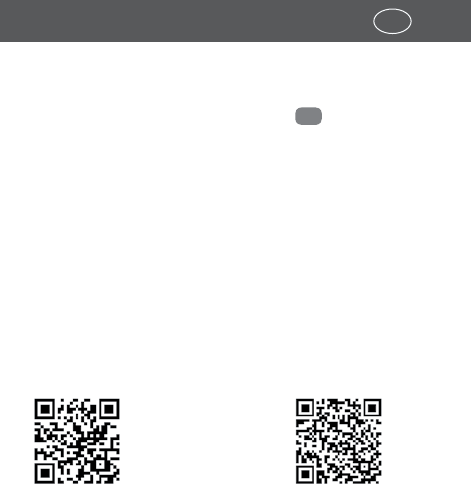
19Setup USA
1. Turn the scale on by briefly stepping on it. The read-
ing “0.0 lb” will then appear on the display.
2. Push and hold the Reset button 5 on the back of
the scale for approx. 3 seconds (see fig.A).
3. The reading “dEL” on the display indicates that the
data is being deleted.
Installing the app
1. Download the free Crane Connect app from the App
Store or from the Google Play Store. You can also
download the app by scanning one of the following
QR codes:
For iOS: For Android™:
You can also download the app under the following
URL:
www.cranesportsconnect.com/downloads.
2. Install the app on your smartphone or tablet. For this,
follow the on-screen instructions.
Creating a user account
The scale has eight user memory slots for storing your
individual settings and measurements and those of
family members for example. For this purpose, an own
user account must be set up for all of those users.

20 Handling
USA
In addition to personal data, the data to be entered in-
clude: gender, date of birth and body height. This data
serves as parameters for determining relative values
such as the BMI.
To create a user account with the app, follow the steps
below:
1. Start the app.
You will be directed to the “Home” menu.
2. Select the app icon “All settings”.
3. To create a new user or log on with an
existing user, select the app icon “User settings”.
4. Follow the step-by-step instructions provided in the app.
You can also create your user data on the following
website: www.cranesportsconnect.com.
Handling
Establishing a Bluetooth® connection
1. Make sure that the Bluetooth® function of your
phone or tablet is switched on.
2. Start the app if you have not already done so.
You will be directed to the “Home” menu.
3. Select the app icon “All settings”.
4. Select the app icon “Diagnostic Scale”.
This will take you to the scale settings. Here you can
determine your level of activity (see chapter “Setting
the level of activity”).

21Handling USA
5. To link the scale to your smartphone or tablet, push
“Connect” in the “Pairing” field.
6. The scale will now activate with the corresponding
user. Every user must step on the scale barefoot to
create a complete scale user record.
7. Go back to the “Home” menu.
8. Select the app icon “Diagnostic Scale” to access the
analyses of your measurements.
If you connect the scale to the app and perform
a measurement, the data will be automatical-
ly uploaded to your user account on the website
www.cranesportsconnect.com if you are connected to
the Internet.
Your data will be securely saved there and will also be
available to you if you lose your smartphone or tablet or
replace it with a new one.
As soon as your user account has been connected with
the scale via the app, you can also perform measure-
ments without having to connect to the app. The next
time you connect the app to the scale, your measure-
ments saved on the scale will also be uploaded to the
website if you are connected to the Internet.
The scale has 30 memory slots for each user. Therefore,
a maximum of 30 measurements can be saved for each
user. Afterwards, “FULL” will appear on the display.
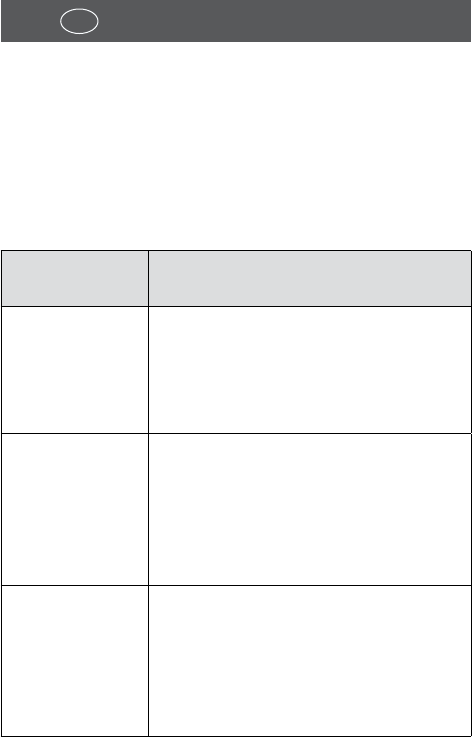
22 Handling
USA
Setting the level of activity
The level of activity is used to calculate your basal and
active metabolic rates in calories.
Realistically consider your lifestyle in the medium to
long-term and then select the correct level of activity.
Use the app to set one of the following activity levels
(see chapter “Establishing a Bluetooth® connection”):
Level of
activity
Description
1 Low level of
activity
You are not active in your free time
or professionally; you spend most
of your time sitting or lying down.
Examples: Elderly persons or people
with physical handicaps.
2 Occasionally
active
You engage in a limited amount of
activity in your free time or profes-
sionally; otherwise you spend most
of your time sitting. Examples: Of-
fice employees, students, precision
mechanics.
3 Moderately
active
You are moderately active in your
free time and walk or stand when
at work. Or you exercise regularly in
addition to your sedentary profes-
sion. Examples: Assembly line works,
craftsmen.
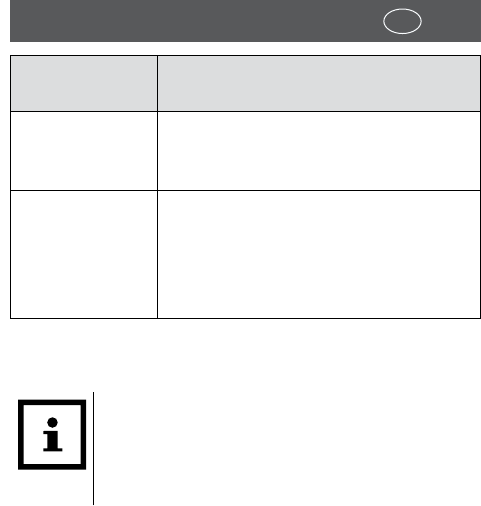
23Handling USA
Level of
activity
Description
4 Active You are active both in your free time
and at work. Examples: Waiters,
salespersons, nursing services.
5 Very active You engage in strenuous physical
activity in your free time and pro-
fessionally. Examples: Construction
workers, farmers, competitive
athletes.
Performing a measurement
NOTICE!
For ideal, comparable measurement results,
follow the basic rules below when perform-
ing a measurement.
− Weigh yourself when undressed, on an empty stom-
ach and if possible, always at the same time of day.
The best time to weigh yourself is in the morning
after you have used the toilet.
− The body fat percentage can only be measured if you
are barefoot. Ideally, your feet should be damp, but
no cream should have been applied.
Completely dry or heavily callused foot soles are not
sufficiently conductive and may affect the accuracy of
results.

24 Handling
USA
− Your feet, legs, calves and thighs may not touch
during measurement.
− When you weigh yourself after getting up, give your
body approx. 15 minutes to enable proper distribu-
tion of the body water percentage in your body.
Proceed as follows to perform a measurement:
1. Make sure that the scale is on a solid, level floor.
2. Stand on the scale so that the soles of both feet are
touching both the front and back measuring elec-
trode 7 (see fig.C).
3. Shift your weight so that it is evenly distributed on
each foot.
4. Stand still and in an upright position during the
measurement.
Your body weight will be displayed in the preset unit
of measurement on the bottom right of the display
(see fig.D).
Then the other values will be measured. The following
measurements will appear in sequence on the top left
of the display:
• BMI (see fig.E),
• “BF” body fat percentage (see fig.F),
• Body water percentage (see fig.G),
• Muscle percentage (see fig.H),
• Bone mass (see fig.I),
• Basal metabolic rate “BMR” (see fig.J),
• Active metabolic rate “AMR”.

25Evaluating the measurements USA
Once the active metabolic rate is shown, the scale will
automatically turn off after approx. four seconds.
5. Step down from the scale.
Evaluating the measurements
NOTICE!
Please keep in mind that all measurements,
with the exception of your body weight,
are only relevant if you have correctly con-
figured your body parameters (age, body
height etc.) in the app.
Restrictions
Please keep in mind that only long-term trends are
relevant with respect to significant fluctuations, particu-
larly in terms of your weight. Always consider the mea-
surements in their relation to one another (see chapter
“Measurements in relation to one another”).
Certain physical characteristics or impairments may lead
the percentage calculations for body water, fat, muscles,
bone and bone density to significantly differ from the
standard values or return false values. The affected per-
sons include:
• Dialysis patients,
• Persons with a fever or suffering from osteoporosis,
• Persons with illnesses leading to oedema,
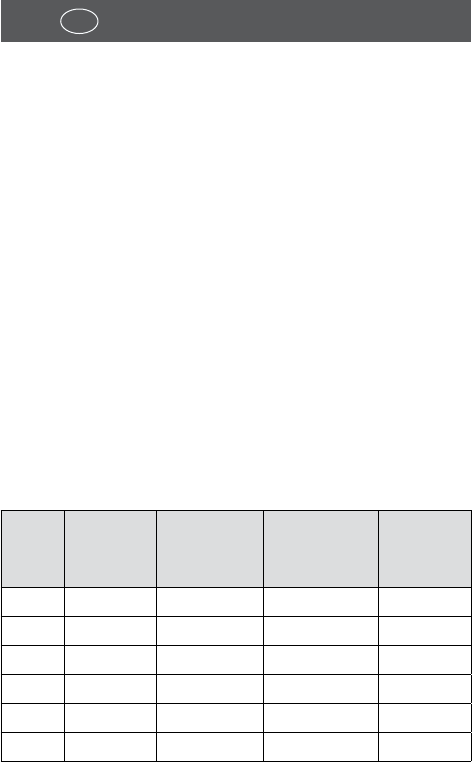
26 Evaluating the measurements
USA
• Persons taking cardiovascular medication (e.g. drugs
influencing vessels, circulatory or heart medication),
• Persons with considerably shorter or longer leg
length,
• Children under 10 years of age.
Body mass index (BMI)
The body mass index is used to distinguish between
underweight, normal weight and overweight. You can
calculate the value as follows:
Weight in lb/(body height in m)2.
The BMI is not very conclusive as an absolute value. It
must be associated with the gender and age of the per-
son. See the reference values provided in the following
tables.
BMI values for women
Age Under-
weight
Normal
weight
Slight
over-
weight
Over-
weight
16–24 <19 19–24 25–28 >28
25–34 <20 20–25 26–29 >29
35–44 <21 21–26 27–30 >30
45–54 <22 22–27 28–31 >31
55–64 <23 23–28 29–32 >32
>65 <24 24–29 30–33 >33
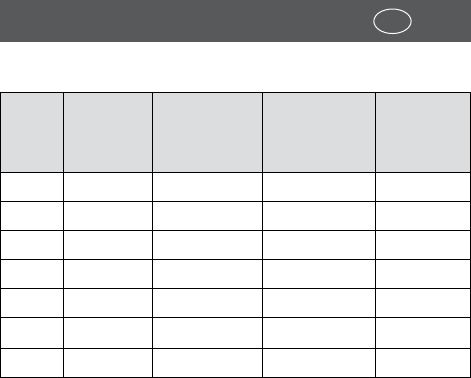
27Evaluating the measurements USA
BMI values for men
Age Under-
weight
Normal
weight
Slight
over-
weight
Over-
weight
16 <19 19–24 25–28 >28
17–24 <29 20–25 26–29 >29
25–34 <21 21–26 27–30 >30
35–44 <22 22–27 28–31 >31
45–54 <23 23–28 29–32 >32
55–64 <24 24–29 30–33 >33
>65 <25 25–30 31–34 >34
Body fat percentage
The tables listed here provide reference values for the
body fat percentage (%). If you require more accu-
rate information about body fat levels in general or
about your own measurements, please speak to your
physician.
Compared to the reference values, active athlete's tend to
have a lower percentage of body fat. Depending on the
level of training and type of sport, these values may be
below the provided reference values.
An extremely low percentage of body fat may pose a
health risk.
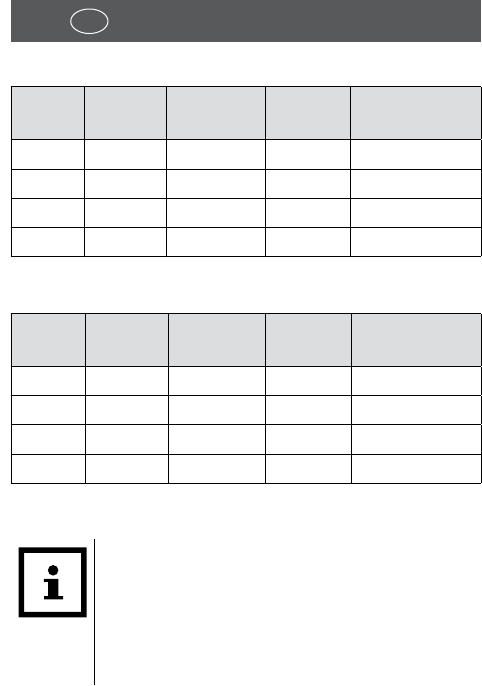
28 Evaluating the measurements
USA
Body fat percentages for women
Age Low Normal Elevat-
ed
Very
elevated
10–29 <23 23–34 35–45 >45
30–59 <23 23–34 35–45 >45
60–69 <23 23–34 35–45 >45
>70 <23 23–37 38–45 >45
Body fat percentages for men
Age Low Normal Elevat-
ed
Very
elevated
10–29 <11 11–24 25–35 >35
30–59 <13 13–25 26–35 >35
60–69 <12 12–25 26–35 >35
>70 <12 12–29 30–35 >35
Body water percentage
NOTICE!
The measurements performed by the scale
do not allow for medically sound conclu-
sions about age-related water retentions. If
you are concerned about your body water
percentage, ask your physician.
The body water percentage is directly related to the per-
centage of body fat and muscle. Body fat contains a rel-
atively low amount of water while muscles tend to store
significantly more water.
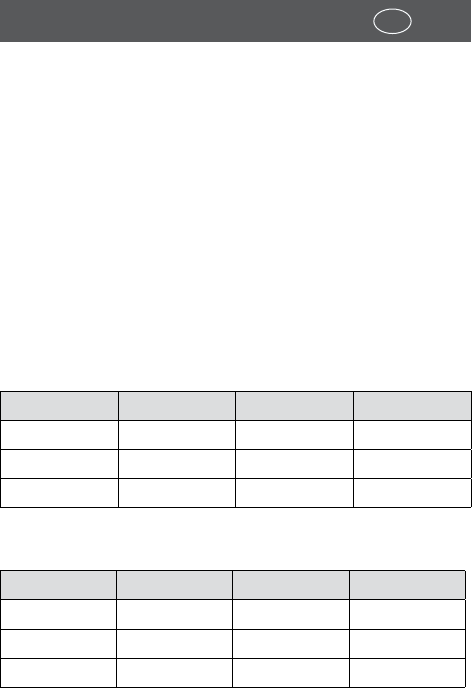
29Evaluating the measurements USA
People with a lower percentage of body fat and high
muscle percentage may exhibit a body water percent-
age that exceeds the reference values (such as endur-
ance athletes).
Vice-versa, the body water percentage for people with a
high percentage of body fat is often less than reference
values.
Generally speaking, a high percentage of body water is
ideal.
The following tables provide an overview of reference
values for the body water percentage (%).
Body water percentage for women
Age Low Normal Elevated
10–29 <52 52–72 >72
30–49 <40 40–60 >60
>50 <45 45–65 >65
Body water percentage for men
Age Low Normal Elevated
10–29 <55 55–75 >75
30–49 <50 50–70 >70
>50 <48 48–68 >68
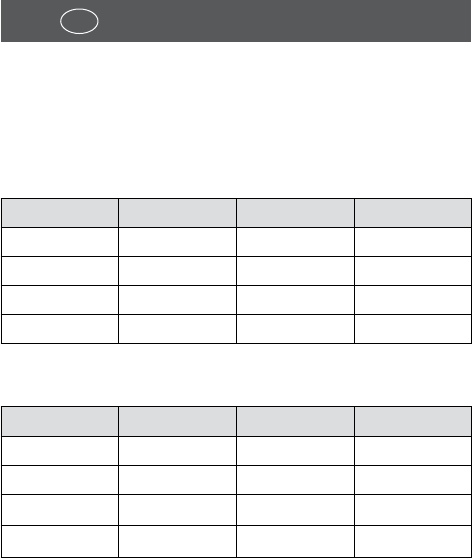
30 Evaluating the measurements
USA
Muscle percentage
The following tables provide an overview of reference
values for the muscle percentage (%).
Muscle percentage for women
Age Low Normal Elevated
10–29 <35 35–45 % >45
30–59 <28 28–40 % >40
60–69 <23 23–35 % >35
>70 <23 23–30 % >30
Muscle percentage for men
Age Low Normal Elevated
10–29 <40 40–50 % >50
30–59 <33 33–45 % >45
60–69 <32 32–40 % >40
>70 <30 30–35 % >35

31Evaluating the measurements USA
Bone mass
NOTICE!
The scale measures the weight of all parts of
your bones in pounds. This is not the same
thing as calcium concentration or bone
density. Only a medical specialist can mea-
sure the calcium concentration and bone
density with a special medical device. The
bone mass therefore does not provide any
information about changes to bones, bone
hardness or diseases such as osteoporosis.
Our skeleton changes as we age. As we grow up, our
bone mass increases quickly and peaks between the
age of 30 and 40. Afterwards, it starts to slowly decline.
Bone mass varies according to gender, height, age and
weight and can only be influenced to a limited extent.
As a result, there are no universally-applicable reference
values.
You can counteract the age-related loss of bone mass
associated with ageing with proper nutrition and phys-
ical activity. At the same time, be sure that you are get-
ting a sufficient amount of vitamin D and calcium. You
can strengthen your skeleton by engaging in athletic
activity to strengthen your muscles.

32 Evaluating the measurements
USA
Basal metabolic rate (BMR)
The basal metabolic rate, BMR, refers to the amount of
energy your body requires on a daily basis when fully
at rest in order to maintain its basic functions. There-
fore, you must consume at least this amount of energy
through your diet to avoid any harm to your health.
Body height, age and weight are the primary factors
that affect the basal metabolic rate. The scale calculates
this value in kilocalories per day (kcal/24h) using the us-
ing the Harris-Benedict formula.
Active metabolic rate (AMR)
The active metabolic rate, AMR, refers to the amount of
energy your body requires on a daily basis during activity.
The scale calculates this amount in kilocalories per day
(kcal/24h).
To maintain your weight, you must consume the amount
of energy that corresponds to your active metabolic rate
through your diet. If you consume less energy than the
calculated active metabolic rate, you will lose weight.
On the other hand, your weight will increase if you con-
sume more energy than your active metabolic rate. How-
ever, if you do not increase the amount of daily physical
activity, increasing the amount of energy consumed will
only cause the percentage of body fat to rise
.
The active metabolic rate is primarily affected by the per-
sonal extent of activity. The scale uses five levels of activity
as calculation parameters.

33Evaluating the measurements USA
Please obtain details on the degrees of activity from the
chapter “Setting the level of activity”.
Measurements in relation to one
another
NOTICE!
Adding up the measurements for water,
fat and muscle percentage does not make
sense because a portion of the body water is
stored in muscle.
In general, only long-term changes to measurements
are really conclusive. The individual results must also be
considered in relation to one another. This leads to three
fundamental aspects:
• Change to the total weight,
• Change to body fat, body water and muscle percent-
age,
• Period during which these changes occur.
The periods are divided into:
Short-term Changes within days
Medium-term Changes within weeks
Long-term Changes within months
Short-term fluctuations in weight are primarily attribut-
ed to changes in the water percentage as the percent-
age of fat and muscle only change over the medium or
long-term.

34 Evaluating the measurements
USA
Short-term weight loss with a simultaneous increase in
the percentage of body fat are also an indication for the
sole loss of water. This could be due to diets or workouts
that target rapid weight loss without sufficient compen-
sation of water loss.
If possible, balance diets with physical activity such
as fitness or strength training to increase your muscle
percentage.
A medium-term increase in weight with a constant or
declining percentage of body fat indicates an increase in
muscle mass.
A decrease in weight and body fat while the muscle per-
centage remains the same or increases is indicative of
an effective diet or workout.
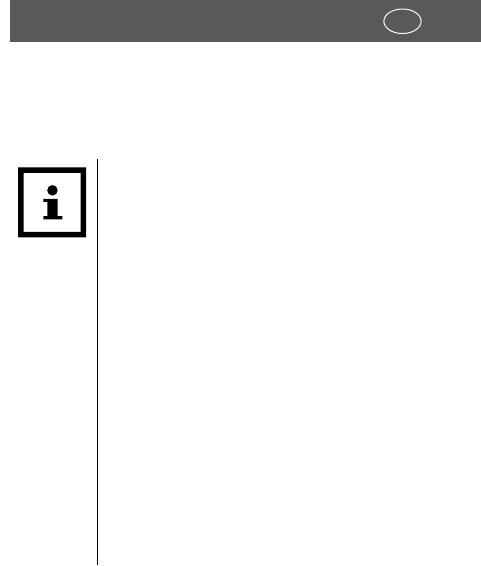
35Cleaning and maintenance USA
Cleaning and maintenance
Cleaning
NOTICE!
Risk of damage to property!
If you do not clean the scale prop-
erly, you could damage it.
− Do not use any aggressive
cleaners or solvents.
− Do not use any brushes with
metal or nylon bristles, sharp
or metallic cleaning utensils
such as knives, hard scrapers
or similar.
− Do not put the scale in the
dishwasher. It would be de-
stroyed as a result.
− Use a cloth moistened with water for cleaning. If
necessary, you can use a small amount of detergent
or a mild soapy solution.
− After cleaning, use a soft cloth to dry the scale.

36 Storage
USA
Changing the batteries
If you stand on the scale and “Lo” appears on the display
instead of the measurements, the batteries are no lon-
ger supplying sufficient power.
If you stand on the scale and nothing appears on the
display, the batteries are empty. To change the batteries,
proceed as follows:
1. Place the scale on a soft base with the bottom facing
up.
2. Open the battery compartment 4 (see fig.B).
3. Take the batteries 3 out of the battery
compartment.
4. Insert new batteries in the battery compartment. Use
batteries of the same type.
The polarity is correct if the negative poles of the
batteries are lined up with the corresponding spring
contacts in the battery compartment.
5. Close the battery compartment.
6. Turn the scale over.
The reading “0.0” will appear on the display.
7. If nothing appears on the display, remove the batter-
ies and insert them again.
Storage
If you do not use the scale for a prolonged period of
time, please observe the following notes:
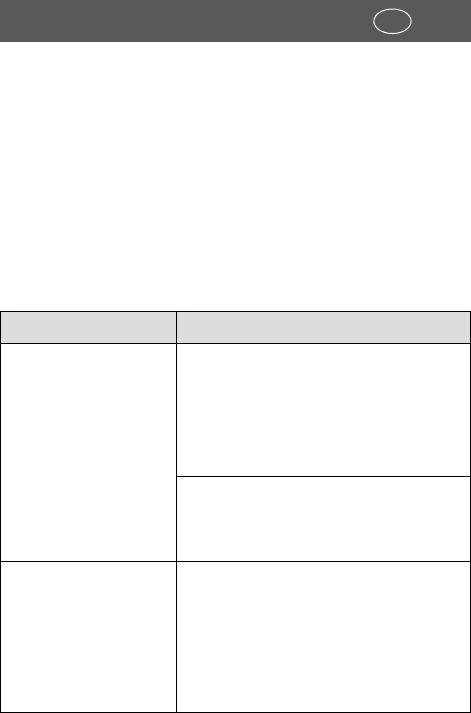
37Troubleshooting USA
− Take the batteries out of the battery compartment.
− Do not store the scale near heat sources.
− Do not place any heavy objects on the scale if you do
not use the scale.
Troubleshooting
If a malfunction occurs, first check the points below be-
fore you send the scale in to be repaired.
Problem Causes and solutions
The display is
blank.
The batteries were not inserted
correctly.
− Remove the batteries and
insert them again. Make sure
the polarity is correct.
Batteries are empty.
− Replace the empty batteries
with new ones.
“Lo” appears on
the display instead
of the measure-
ments and the
scale immediately
turns off.
The batteries no longer supply a
sufficient amount of power.
− Replace the batteries with
new ones.

38 Troubleshooting
USA
Problem Causes and solutions
“Err” appears
on the display
instead of the
measurements.
The upper limit of the measure-
ment range (396 lb) has been
exceeded.
− Do not exceed the scale's car-
rying capacity of 396 lb.
You failed to stand still during the
measuring process or to evenly
distribute your body weight to
both feet.
− Stand still while the measure-
ments are being performed
and evenly distribute your
weight to both feet.
Only the weight is
shown.
You were not barefoot during the
measurement, the soles of your
feet are too dry or you have too
much callused skin on the soles
of your feet.
− Repeat the measurement
barefoot.
− If necessary, slightly moisten
the soles of your feet.
− Remove any callused skin
from the soles of your feet.
The percentage
of fat is outside
the measurement
range (< 5 % or >
50 %).

39Troubleshooting USA
Problem Causes and solutions
The scale was not
at zero when the
weighing process
was initiated.
The scale did not adjust properly.
− Wait until the scale turns off
on its own.
− Step on the scale again and
wait until “0.0” appears on the
display.
− Repeat the measurement.
No connection is
established be-
tween your smart-
phone or tablet
and the scale even
after approx. 180
seconds.
The Bluetooth® function of your
smartphone or tablet is switched
off.
− Switch the Bluetooth® func-
tion of your smartphone or
tablet on.
The scale's Bluetooth® receiver is
not working properly.
− Take the batteries out of the
battery compartment.
− Put the batteries back in.
− Switch the Bluetooth® func-
tion of your smartphone or
tablet
off and back on.
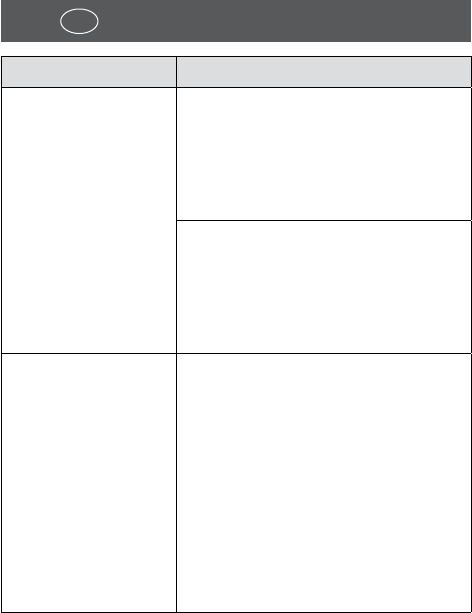
40 Troubleshooting
USA
Problem Causes and solutions
No connection is
established be-
tween your smart-
phone or tablet
and the scale even
after approx. 180
seconds.
Your smartphone or tablet is not
working properly.
− Switch off your smartphone or
tablet off completely and then
back on.
The app was not successfully
installed on your smartphone or
tablet.
− Reinstall the app and log in
with your user data.
Not all measure-
ments saved are
transmitted.
You performed more than 30
measurements without connect-
ing to the app.
The scale can save a total of 30
measurements after a user has
been created. Afterwards, “Full”
will appear on the display.
− Connect the scale with the
app on a regular basis to pre-
vent losing measurements.
Use the FAQs (frequently asked questions) on the fol-
lowing website as an additional help for your scale:
www.cranesportsconnect.com/faq.
If the measures described above have not resolved the
problem, please contact our service team. Use the infor-
mation provided below and also consider the chapter
“Warranty”.
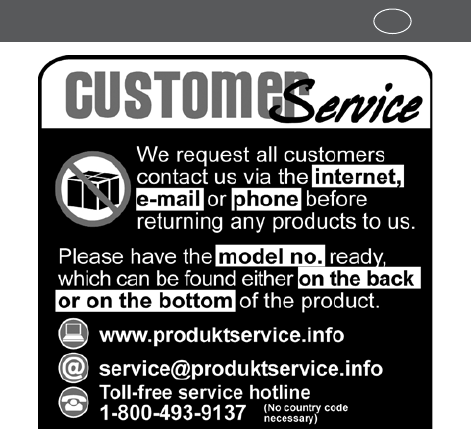
41Technical data USA
Technical data
Type: AU5-CDSC-1
Article number: 92125
Power supply: Batteries, 3 x 1.5 V DC,
type LR03/R03/AAA
Materials
Scale surface: Safety glass, 6 mm thick
Electrodes: non-rusting steel
Housing: ABS plastic

42 Declaration of conformity
USA
Dimensions (W x D x H): 11.9 x 11.8 x 0.9 “
(30 x 30 x 2.3 cm)
Upper limit of the
measurement range:
180 kg / 396 lb / 28 st
Lower limit of the
measurement range:
3 kg / 6.6 lb / 0 st (≈ 6.6 lb)
Display accuracy
Weight: 0.1 kg / 0.2 lb / 0.2 lb
Bone mass: 0.1 kg / 0.2 lb / 0.2 lb
Body fat percentage: 0.1 %
Body water percentage:0.1 %
Muscle percentage: 0.1 %
Calorie requirement: 1 kcal
Declaration of conformity
This device complies with Part 15 of the FCC Rules. Oper-
ation is subject to the following two conditions: (1) this
device may not cause harmful interference, and (2) this
device must accept any interference received, including
interference that may cause undesired operation.
NOTE:
This equipment has been tested and found to
comply with the limits of a Class B digital device, pursuant
to Part 15 of the FCC Rules. These limits are designed to

43Declaration of conformity USA
provide reasonable protection against harmful interfer-
ence in a residential installation. This equipment gener-
ates, uses and can radiate radio frequency energy and, if
not installed and used in accordance with the instructions,
may cause harmful interference to radio communications.
However, there is no guarantee that interference will not
occur in a particular installation. If this equipment does
cause harmful interference to radio or television recep-
tion, which can be determined by turning the equipment
off and on, the user is encouraged to try to correct the in-
terference by one or more of the following measures:
• Reorient or relocate the receiving antenna.
• Increase the separation between the equipment and
receiver.
• Connect the equipment into an outlet on a circuit dif-
ferent from that to which the receiver is connected.
• Consult the dealer or an experienced radio/TV tech-
nician for help.
WARNING: changes or modifications to this unit not
expressly approved by the party responsible for com-
pliance could void user’s authority to operate the
equipment.

44 Disposal
USA
Disposal
Disposing of packaging
− Sort the packaging before you dispose of it. Dispose
of paperboard and cardboard with the recycled pa-
per service and wrappers with appropriate collection
service.
Disposing of the diagnostic scale
− Should the diagnostic scale no longer be capable
of being used at some point in time, dispose of it in
accordance with the regulations in force in your state
or country.
Batteries and storage batteries may not be disposed
of with household waste!
As the end user you are required by law to bring all bat-
teries and storage batteries, regardless whether they
contain harmful substances* or not, to a collection point
run by the communal authority or borough or to a retail-
er, so that they can be disposed of in an environmentally
friendly manner. Turn in the batteries and storage bat-
teries at your collection point in a discharged state only!
* labelled with: Cd = cadmium, Hg = mercury, Pb = lead

45Contenido USA
Contenido
Conjunto ........................................................................... 4
Uso ................................................................................... 5
Volumen de suministro/partes del aparato ................... 6
Códigos QR ........................................................................ 47
Generalidades ...................................................................48
Leer y guardar este manual del usuario ........................... 48
Descripción de símbolos .......................................................49
Seguridad .........................................................................50
Uso apropiado ....................................................................... 50
Indicaciones de seguridad .................................................. 50
Comprobar la balanza y el volumen de suministro .........54
Balanza y aplicación Crane Connect ................................. 55
Funciones ................................................................................55
Método de medición............................................................. 56
Compatibilidad .......................................................................57
Uso sin App ............................................................................ 58
Puesta en marcha ............................................................. 59
Colocación de las pilas ......................................................... 59
Colocación de la balanza ..................................................... 59
Colocación de las bases para moquetas ........................... 60
Ajuste de unidades de medida de peso ............................ 60
Reseteo de la memoria de la balanza................................ 60
Instalación de la aplicación .................................................. 61
Creación de cuenta de usuario ............................................ 61
Uso ................................................................................... 62
Establecimiento de conexión Bluetooth® .........................62
Ajuste del grado de actividad ............................................. 64
Realización de la medición .................................................. 66

46 Contenido
USA
Evaluación de resultados de medición ............................68
Restricciones.......................................................................... 68
Índice de masa corporal (BMI) ............................................ 69
Porcentaje de grasa corporal ...............................................70
Porcentaje de agua corporal .................................................71
Porcentaje de masa muscular .............................................73
Masa ósea ................................................................................74
Consumo de calorías en reposo (BMR) ...............................75
Consumo de calorías en la vida cotidiana (AMR) ..............76
Valores de medición en relación con otros valores ..........77
Limpieza y mantenimiento ............................................... 79
Limpieza ..................................................................................79
Cambio de pilas .....................................................................80
Almacenamiento .............................................................. 81
Búsqueda de fallos ........................................................... 81
Datos técnicos ................................................................... 87
Declaración de conformidad ............................................88
Eliminación .......................................................................90
Eliminación del embalaje .................................................... 90
Equipo en desuso ................................................................. 90
Garantía ........................................................................... 91
Tarjeta de garantía ................................................................ 91
Condiciones de garantía .......................................................94

47
USA
Códigos QR
Los códigos QR le ayudan a encontrar
la información que busca fácilmente y
rápidamente
Si busca información sobre el producto, recambios o
accesorios, garantías y soporte postventa, o si quiere ver
un vídeo que le muestra el producto, los códigos QR le
ayudan a encontrar lo que busca rápidamente.
¿Qué es un código QR?
Un código QR (QR = respuesta rápida) es un código
de barras que se puede leer con la cámara de su
smartphone y que contiene, por ejemplo, un enlace a
una página web o información de contacto. Ventaja: No
es necesario introducir estos datos de forma manual.
Como funciona
Para escanear el código QR sólo necesita un smartphone
con software que puede leer los datos QR y una
conexión a internet*. Este tipo de software está
disponible gratis en el app store de su smartphone.
Pruébalo ahora
Escanea el código QR con su smartphone para averiguar
más sobre el producto Aldi que ha comprado*.
* Según su tarifa pueden aplicarse cargos de conexión.
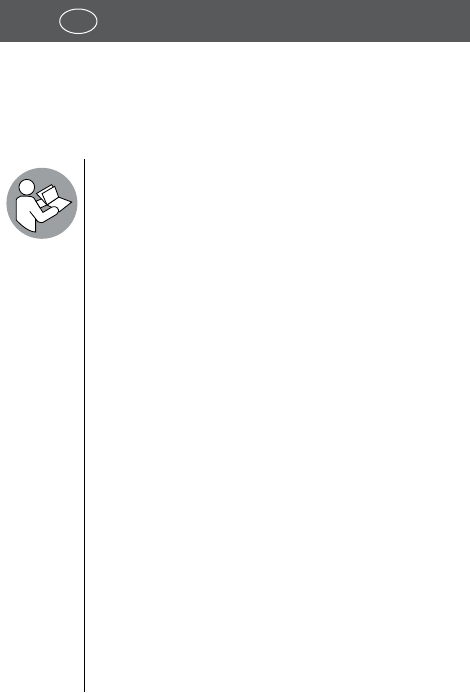
48 Generalidades
USA
Generalidades
Leer y guardar este manual del usuario
Este manual del usuario pertenece a esta
balanza con diagnóstico por Bluetooth®.
Contiene información importante sobre la
puesta en marcha y el uso.
En aras de una mejor comprensión, la
balanza con diagnóstico por Bluetooth® se
denominará en lo sucesivo simplemente:
“balanza”.
Antes de utilizar la balanza, lea
detenidamente el manual del usuario,
sobre todo las indicaciones de seguridad. La
inobservancia de este manual del usuario
puede provocar daños en la balanza.
El manual del usuario se basa en las
normas y regulaciones vigentes en la
Unión Europea. Para el extranjero, respete
también las directivas y leyes de cada país.
Guarde el manual del usuario para uso
posterior. Si transmite la balanza a una
tercera persona, entregue necesariamente
este manual del usuario.
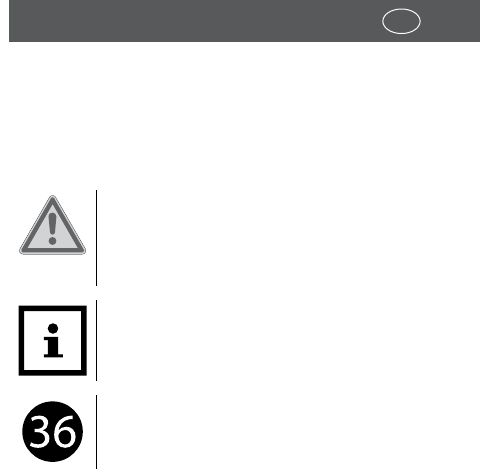
49
USA
Generalidades
Descripción de símbolos
En este manual del usuario, en la balanza y en el
embalaje se utilizan los siguientes símbolos y términos
de advertencia.
¡ADVERTENCIA! Este término de
advertencia hace referencia a un grado
de riesgo medio, que si no se evita, puede
provocar la muerte o lesiones graves.
¡AVISO! Este término de advertencia
previene daños materiales o le proporciona
información adicional útil para el uso.
Este símbolo indica que la garantía para la
balanza asciende a 36 meses (3 años).

50 Seguridad
USA
Seguridad
Uso apropiado
La balanza está diseñada exclusivamente como medio
auxiliar para la medición e indicación de sus datos
corporales. La balanza está concebida exclusivamente
para uso privado, no para el ámbito industrial o clínico.
La balanza no es un aparato médico, ni un juguete.
Utilice la balanza sólo como se describe en este
manual del usuario. Cualquier otro uso se considera
inapropiado, y puede provocar lesiones o daños en la
balanza.
El fabricante o distribuidor no se hacen responsables de
daños producidos por uso inapropiado o erróneo.
Indicaciones de seguridad
¡ADVERTENCIA!
¡Riesgo de lesiones!
Si utiliza la balanza de forma
inapropiada, existe mayor riesgo
de lesiones.
− No utilice la balanza si está supeditado a
implantes médicos (p. ej. marcapasos).
La tensión de medición del análisis de
impedancia bioeléctrica de la balanza
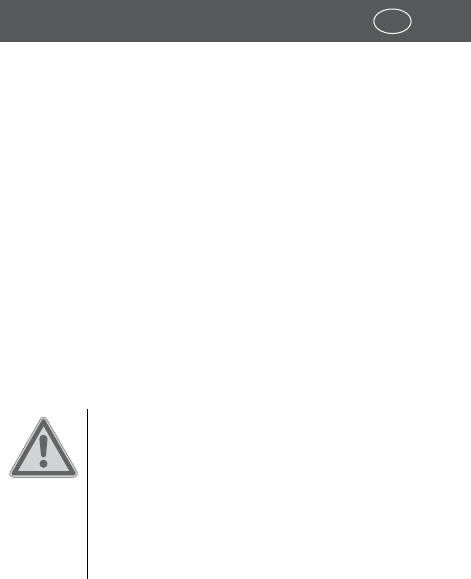
51Seguridad USA
puede menoscabar las funciones de
tales implantes.
− No utilice la balanza si está embarazada.
− No se coloque unilateralmente sobre el
borde exterior de la balanza.
− No se suba en la balanza con los pies
mojados o si acaba de aplicar crema a
los mismos.
− Seque la superficie de la balanza antes
de usarla.
− Si la balanza presenta daños visibles, no
la utilice.
¡ADVERTENCIA!
¡Riesgos por el uso de pilas!
La balanza funciona con pilas. La
manipulación inadecuada de las
pilas puede provocar lesiones y
daños materiales.
− Guarde las pilas lejos del alcance de los
niños. Si sospecha que un niño se ha
tragado una pila, acuda inmediatamente
a un médico.
− No exponga nunca las pilas a un calor
excesivo, como radiación solar directa,
fuego abiertoo similar.

52 Seguridad
USA
− No cargue las pilas, ni las reactive con
otros medios.
− No cortocircuite las pilas.
− No abra las pilas.
− Para evitar que el líquido de las pilas
se derrame, en la balanza sólo han de
utilizarse pilas del mismo tipo.
− Las pilas descargadas han de retirarse
inmediatamente de la balanza.
− Evite el contacto del ácido de batería
con la piel, los ojos y las membranas
mucosas. Si entra en contacto con el
ácido de la pila, enjuague al instante
las zonas afectadas con agua limpia
abundante y consulte a un médico de
inmediato.
− Si el líquido de las pilas se derrama en
la balanza, use guantes para retirarlo. A
continuación, limpie el compartimento
de pilas con un paño,
sin agua ni
detergente.
− Si no utiliza la balanza durante un
periodo de tiempo prolongado, saque
las pilas del compartimento de pila.

53Seguridad USA
¡AVISO!
¡Riesgo de daños!
El uso inadecuado de la balanza
puede provocar daños en la
misma.
− No exponga la balanza a campos
magnéticos muy intensos (p. ej.
transformadores), pues en otro
caso pueden producirse fallos en la
transmisión de datos o daños en la
balanza.
− No abra la balanza.
− No sumerja la balanza en el agua, ni la
lave con agua corriente.
− Proteja la balanza contra golpes y
productos químicos.
− No exponga la balanza a fluctuaciones
extremas de temperatura.
− No coloque la balanza cerca de fuentes
de calor intenso (p. ej. estufas o
radiadores).
− No coloque ningún objeto sobre la
balanza cuando no la utilice.
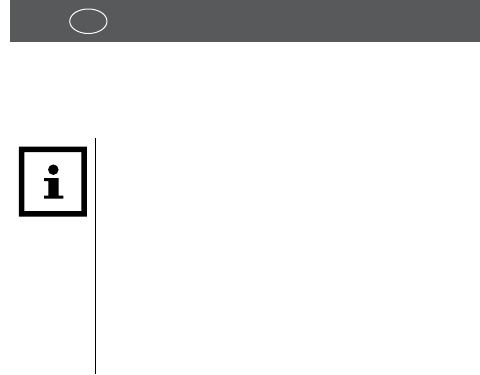
54 USA Comprobar la balanza y el volumen
Comprobar la balanza y el
volumen de suministro
¡AVISO!
¡Riesgo de daños!
Si abre el embalaje con un
cuchillo afilado o con otros objetos
puntiagudos sin tener cuidado, la
balanza puede sufrir daños.
− Por tanto, al abrir el embalaje,
proceda con cuidado.
1. Saque la balanza y sus accesorios del embalaje.
2. Retire el material de embalaje.
3. Compruebe si el suministro está completo
(véase la fig.A).
4. Compruebe si la balanza o las piezas individuales
presentan daños. Si éste es el caso, no utilice la
balanza. Contacte con el fabricante a través de la
dirección de servicio técnico indicada en la tarjeta de
garantía.

55
USA
Balanza y aplicación Crane Connect
Balanza y aplicación Crane
Connect
La balanza sirve para el pesaje y el diagnóstico de
datos corporales individuales. Los datos medidos
se transmiten a un smartphone o tablet mediante
Bluetooth®. Con la aplicación gratuita Crane Connect
(en lo sucesivo: “aplicación“), esos datos pueden
guardarse y analizarse en el smartphone o tablet.
La balanza puede registrar y transferir los datos
corporales de hasta ocho usuarios distintos. Los datos
sólo están siempre visibles para el usuario actual, no
para otros usuarios.
Funciones
La balanza tiene las siguientes funciones:
• Medición del peso corporal (véase la fig.D).
• Determinación del índice de masa corporal “BMI“
(véase la fig.E).
• Determinación del porcentaje de grasa corporal “BF“
en % (véase la fig.F).
• Determinación del porcentaje de agua corporal en %
(véase la fig.G).
• Determinación del porcentaje de masa muscular en %
(véase la fig.H).
• Determinación de la masa ósea en lbs (véase la fig.I).
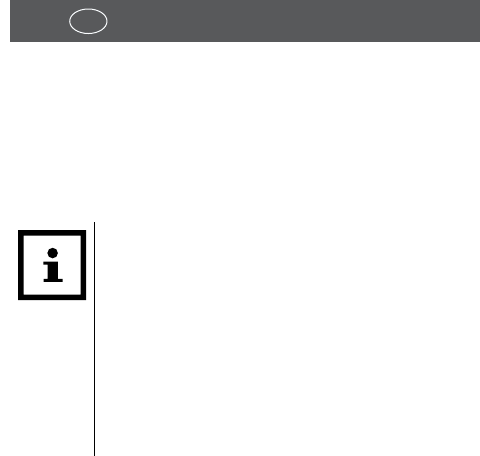
56 Balanza y aplicación Crane Connect
USA
• Determinación del consumo de calorías en reposo
“BMR” en kcal (véase la fig.J).
• Determinación del consumo de calorías en la vida
cotidiana “AMR” en kcal.
Método de medición
¡AVISO!
Los resultados del análisis de la balanza sólo
tienen una precisión aproximada desde
el punto de vista médico. Las mediciones
exactas de porcentajes de grasa y agua
corporal y masa muscular o masa ósea
sólo pueden realizarse por un médico
especialista con instrumentos médicos
especiales.
Para la medición de sus datos corporales, la balanza
utiliza una tensión eléctrica muy pequeña. Dicha
tensión se aplica al cuerpo, o más específicamente, a
las distintas partes del mismo. En el cuerpo, la corriente
encuentra diferentes resistencias. El agua y el tejido
muscular tienen una resistencia baja, y por tanto, son
buenos conductores eléctricos. El tejido adiposo y los
huesos son malos conductores eléctricos, y por tanto,
tienen una resistencia alta.

57Balanza y aplicación Crane Connect USA
Esas resistencias o impedancias se miden y utilizan en
relación con las características corporales individuales
– como tamaño, edad y sexo – para calcular los
porcentajes de agua, huesos y músculos. Este método
de medición se denomina “análisis de impedancia
bioeléctrica” (BIA).
Compatibilidad
Los smartphones y tablets provistos de Bluetooth® Smart
Ready (Bluetooth®4.0) y especificados a continuación
son compatibles con la balanza y la aplicación:
• Apple® iPhone® 4s y versiones posteriores
• Apple® iPad® de la 3ª generación y versiones
posteriores
• Apple® iPad mini™ de la 1ª generación y versiones
posteriores
• Apple® iPad Air™ y versiones posteriores
• Smartphones y tablets con Android™ 4.3 y versiones
posteriores
En el sitio web siguiente puede encontrar una lista
detallada de dispositivos compatibles:
www.cranesportsconnect.com/compatibility.
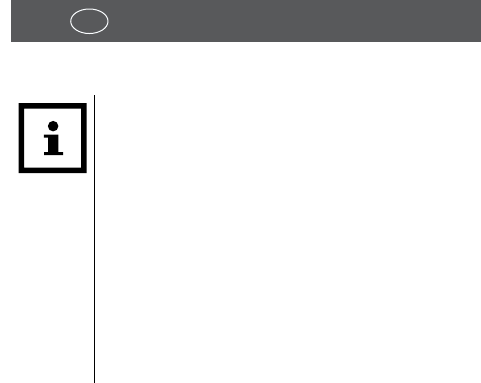
58 Balanza y aplicación Crane Connect
USA
Uso sin App
¡AVISO!
Si utiliza la balanza sin la aplicación, la
balanza sólo puede medir correctamente
su peso. Si no se utiliza la aplicación, todos
los demás valores de medición se calculan
con los parámetros estándar, y por tanto
tienen inevitablemente una mayor o menor
precisión.
Por otra parte, si utiliza la balanza sin la
aplicación, los datos medidos no se guardan
en la balanza.
Para el cálculo de sus porcentajes de grasa y agua
corporal, masa muscular y ósea, así como BMI, AMR y
BMR, la balanza necesita parámetros individuales, p.
ej. sexo, tamaño y edad. Sin embargo, esos parámetros
no pueden ajustarse en la propia balanza, sino sólo a
través de la aplicación o del sitio web de Crane (véase el
capítulo “Creación de cuenta de usuario”).
Sin la entrada de esos parámetros individuales,
los resultados de medición pueden diferir
considerablemente de sus valores individuales reales.
Análogamente, si la balanza se utiliza sin aplicación,
el peso se indica sin identificación de usuario. Le
recomendamos que utilice la balanza con la aplicación.

59Puesta en marcha USA
Puesta en marcha
Colocación de las pilas
1. Coloque la balanza sobre una base suave con la parte
superior hacia abajo.
2. Abra el compartimento de pilas 4 (véase la fig.B).
3. Retire la lámina de protección de las pilas
suministradas 3.
4. Inserte las pilas en el compartimento de pilas.
La polaridad es correcta si los polos negativos
de las pilas tocan los contactos de muelle del
compartimento de pilas.
5. Cierre el compartimento de pilas.
6. Voltee la balanza.
En el display aparece la indicación “0.0”.
7. Si el display no indica nada, retire las pilas y vuelva a
colocarlas.
Colocación de la balanza
Para registrar valores de medición correctos, la balanza
tiene que encontrarse sobre un revestimiento de suelo
firme o sobre las bases para moquetas incluidas en el
suministro:
− En moqueta, utilice las bases para moquetas.
− Coloque la balanza en un suelo liso y firme.

60 Puesta en marcha
USA
Colocación de las bases para moquetas
1. Coloque la balanza sobre una base suave con la parte
superior hacia abajo.
2. Inserte las bases para moquetas 2 en las patas 6
(véase la fig.A).
Ahora puede utilizar la balanza sobre moquetas.
Ajuste de unidades de medida de peso
Si la balanza se suministra a Europa (excluyendo Gran
Bretaña e Irlanda), la misma está ajustada en kilogramos
(kg). Si la balanza se suministra a Gran Bretaña, Irlanda
y EE.UU., la misma está ajustada en libras (lb). Con la
aplicación puede cambiarse la unidad de medida.
Reseteo de la memoria de la balanza
Usted puede restablecer el estado de suministro de la
balanza borrando todos los datos:
1. Conecte la balanza pisándola brevemente. El display
indica después “0.0 lb”.
2. Presione la tecla Reset 5 en la parte posterior de la
balanza durante aprox. 3 segundos (véase la fig.A).
3. La balanza indica el borrado de los datos con “dEL”
en el display.
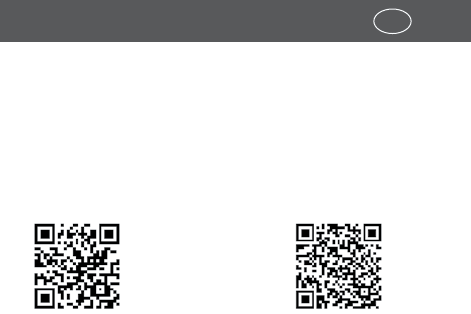
61Puesta en marcha USA
Instalación de la aplicación
1. Descargue la aplicación gratuita Crane Connect
desde App Store o Google Play Store. También puede
descargar la aplicación escaneando uno de los
códigos QR siguientes:
Para iOS: Para Android™:
También puede descargar la aplicación en el URL
siguiente:
www.cranesportsconnect.com/downloads.
2. Instale la aplicación en su smartphone o tablet. Para
ello, siga las instrucciones en la pantalla.
Creación de cuenta de usuario
La balanza tiene ocho posiciones de memoria de
usuario donde usted y por ejemplo los miembros de su
familia pueden guardar ajustes y valores de medición
individuales. A ese respecto, para cada uno de esos
usuarios ha de crearse una cuenta de usuario propia.

62 Uso
USA
Los datos que han de introducirse incluyen – junto
con los datos personales – entre otros: sexo, fecha
de nacimiento y altura. Estos datos se utilizan como
parámetros para calcular valores relativos, p. ej. el BMI.
Para crear una cuenta de usuario a través de la
aplicación, proceda de la siguiente forma:
1. Arranque la aplicación.
Accederá al menú “Inicio” ("Home").
2. Seleccione el símbolo de aplicación “Todos los
ajustes” ("All settings").
3. Para crear un nuevo usuario o iniciar sesión con un
usuario ya existente, seleccione el símbolo de
aplicación “Ajustes de usuario” ("User settings").
4. Siga paso a paso las instrucciones en la aplicación.
Usted puede crear sus datos de usuario en el sitio web
siguiente: www.cranesportsconnect.com.
Uso
Establecimiento de conexión
Bluetooth®
1. Asegúrese de que la función Bluetooth® esté
activada en su teléfono o tablet.
2. Arranque la aplicación, si no lo ha hecho aún.
Accederá al menú “Inicio” ("Home").
3. Seleccione el símbolo de aplicación “Todos los ajustes”
("All settings").

63Uso USA
4. Seleccione el símbolo de aplicación “Balanza de
diagnóstico” ("Diagnostic Scale").
Accederá a los ajustes para la balanza, donde puede
determinar su grado de actividad (véase el capítulo
“Ajuste del grado de actividad”).
5. Para conectar la balanza con su smartphone o
tablet, presione “Conectar” ("Connect") en el campo
“Acoplar” ("Pairing").
6. Ahora, la balanza se conecta con el usuario
correspondiente. Cada usuario tiene que colocarse
una vez en la balanza descalzo, para que se cree
plenamente como usuario de la balanza.
7. Vuelva al menú “Inicio” ("Home").
8. Seleccione el símbolo de aplicación “Balanza de
diagnóstico” ("Diagnostic Scale"), para acceder a las
evaluaciones de sus mediciones.
Si conecta la balanza con la aplicación y realiza una
medición, los datos se cargan automáticamente
en su cuenta de usuario en el sitio web
www.cranesportsconnect.com si existe conexión a
Internet.
Allí están guardados sus datos de forma segura, y se
mantienen aunque pierda su smartphone o tablet o los
sustituya por aparatos nuevos.
Tan pronto como su cuenta de usuario se conecte una
vez con la balanza a través de la aplicación, también
puede realizar mediciones sin conexión a la aplicación.

64 Uso
USA
Cuando conecte la aplicación la próxima vez a la
balanza, sus mediciones guardadas en la balanza
también se cargan en el sitio web si existe conexión a
Internet.
La balanza tiene 30 posiciones de memoria para cada
usuario. Por tanto, es posible guardar un máximo de
30 mediciones por usuario. A continuación, el display
indica “FULL”.
Ajuste del grado de actividad
El grado de actividad se utiliza para calcular su tasa
metabólica básica y activa en kilocalorías.
Para seleccionar el grado de actividad adecuado,
contemple su modo de vida de forma realista y a medio
y largo plazo. Ajuste uno de los siguientes grados de
actividad a través de la aplicación (véase el capítulo
“Establecimiento de conexión Bluetooth®”):
Grado de
actividad
Descripción
1 Poca actividad Usted no desarrolla ninguna
actividad en su tiempo libre ni en
su profesión, y pasa su tiempo
principalmente sentado o tumbado.
Ejemplos: personas mayores o
personas con discapacidad física.
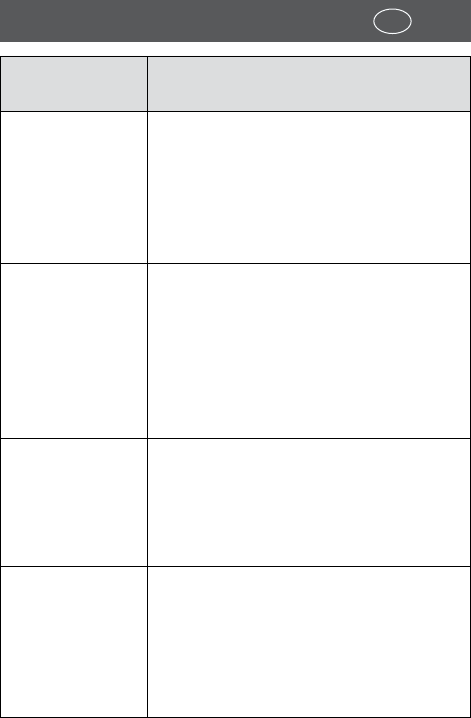
65Uso USA
Grado de
actividad
Descripción
2 Actividad
ocasional
Usted desarrolla una ligera actividad
en su tiempo libre o en su profesión,
y por lo demás pasa su tiempo
principalmente sentado. Ejemplos:
administrativos, estudiantes,
mecánicos de precisión.
3 Actividad
media
Usted desarrolla una actividad media
en su tiempo libre y en su profesión,
en la cual camina o está sentado, o
practica deporte regularmente junto
con su actividad profesional sentada.
Ejemplos: trabajadores de cadena de
fabricación, obreros.
4 Actividad
habitual
Usted desarrolla actividad tanto
en su tiempo libre como en su
profesión. Ejemplos: camareros,
vendedores, trabajadores de servicio
de enfermería.
5 Mucha
actividad
Usted desarrolla actividades
físicamente extenuantes tanto
en su tiempo libre como en su
profesión. Ejemplos: trabajadores
de la construcción, agricultores,
deportistas profesionales.

66 Uso
USA
Realización de la medición
¡AVISO!
Para lograr resultados de medición óptimos
y comparables, respete las siguientes reglas
básicas.
− Pésese sin ropa, en ayunas y – a ser posible –
siempre a la misma hora. El momento ideal es por la
mañana después de ir al baño.
− El porcentaje de grasa corporal sólo puede medirse
descalzo. En el mejor de los casos, sus pies deberían
estar ligeramente húmedos, pero no cremosos.
Las plantas de pies totalmente secas o muy callosas
no son lo suficientemente conductoras y pueden
proporcionar resultados inexactos.
− Durante la medición, los pies, las piernas, las
pantorrillas y los muslos no deben tocarse.
− Si se pesa al levantarse, espere unos 15 minutos
para que su cuerpo distribuya correctamente el
porcentaje de agua corporal.
Para realizar una medición, proceda de la siguiente
forma:
1. Asegúrese de que la balanza se encuentra sobre un
suelo liso y firme.
2. Colóquese con los pies sobre la balanza, de forma
que las plantas de ambos pies toquen el electrodo de
medición 7 delantero y trasero (véase la fig.C).

67Uso USA
3. Disponga su peso uniformemente sobre ambos pies.
4. Durante la medición, sitúese en posición vertical y
quédese quieto.
En la parte inferior derecha del display, primero
se indica su peso corporal en la unidad de medida
preajustada (véase la fig.D).
Después empieza la medición para los demás valores.
En la parte superior izquierda del display se indican
sucesivamente los siguientes valores de medición:
• BMI (véase la fig.E),
• Porcentaje de grasa corporal “BF” (véase la fig.F),
• Porcentaje de agua corporal (véase la fig.G),
• Porcentaje de masa muscular (véase la fig.H),
• Masa ósea (véase la fig.I),
• Tasa metabólica básica “BMR” (véase la fig.J),
• Tasa metabólica activa “AMR”.
Tras la indicación de la tasa metabólica activa, la
balanza se desconecta automáticamente al cabo de
aprox. cuatro segundos.
5. Bájese de la balanza.

68 USA Evaluación de resultados
Evaluación de resultados de
medición
¡AVISO!
Tenga en cuenta que a excepción de su
peso corporal, todos los valores de medición
sólo son significativos si sus parámetros
corporales (edad, altura, etc.) se han
ajustado correctamente en la aplicación.
Restricciones
Tenga en cuenta que en caso de grandes desviaciones,
sobre todo en el peso, sólo cuentan los cambios a largo
plazo. Los valores de medición han de contemplarse
siempre en relación con otros valores (véase el capítulo
“Valores de medición en relación con otros valores“).
En caso de determinadas características físicas o
dolencia, el cálculo de los porcentajes de agua, grasa,
músculos y huesos, así como de la densidad ósea,
puede diferir bastante de los valores normativos o
proporcionar valores erróneos. Entre las personas
afectadas se cuentan:
• Pacientes de diálisis,
• Personas que padezcan fiebre u osteoporosis,
• Personas con enfermedades que originen edema,
• Personas que tomen medicamentos cardiovasculares
(p. ej. preparaciones que alteren los vasos sanguíneos,
medicamento para la circulación o el corazón),
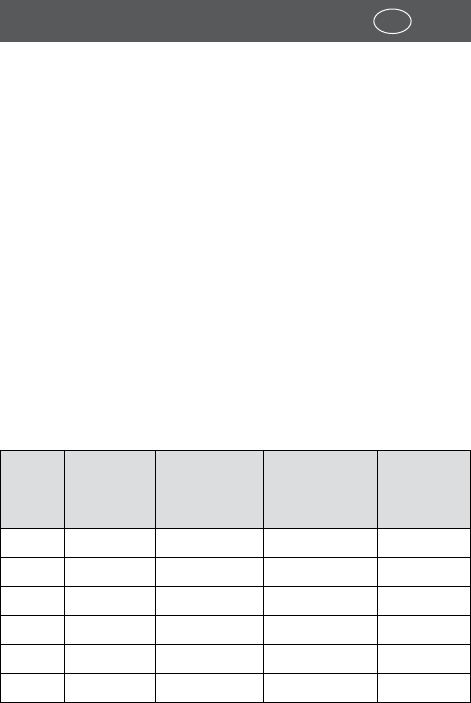
69
USA
Evaluación de resultados
• Personas cuya longitud de pierna se haya acortado o
alargado considerablemente,
• Niños menores de 10 años.
Índice de masa corporal (BMI)
El valor del índice de masa corporal se utiliza para
diferenciar entre falta de peso, peso normal y exceso de
peso. El valor puede calcularse de la siguiente forma:
Peso en lbs/(altura en m)2.
El BMI no es muy significativo como valor absoluto. Tiene
que ponerse en relación con el sexo y la edad de la
persona. Para ello, ríjase por los valores de comparación
de las tablas siguientes.
Valores BMI para mujeres
Edad Falta de
peso
Peso
normal
Ligero
exceso de
peso
Exceso
de peso
16–24 <19 19–24 25–28 >28
25–34 <20 20–25 26–29 >29
35–44 <21 21–26 27–30 >30
45–54 <22 22–27 28–31 >31
55–64 <23 23–28 29–32 >32
>65 <24 24–29 30–33 >33
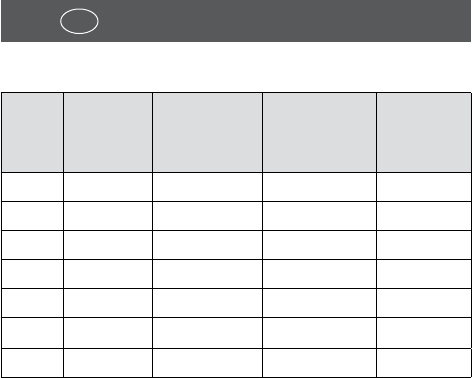
70 USA Evaluación de resultados
Valores BMI para hombres
Edad Falta de
peso
Peso
normal
Ligero
exceso de
peso
Exceso
de peso
16 <19 19–24 25–28 >28
17–24 <29 20–25 26–29 >29
25–34 <21 21–26 27–30 >30
35–44 <22 22–27 28–31 >31
45–54 <23 23–28 29–32 >32
55–64 <24 24–29 30–33 >33
>65 <25 25–30 31–34 >34
Porcentaje de grasa corporal
Las tablas especificadas aquí muestran valores
orientativos para el porcentaje de grasa corporal (%).
Si necesita información más exacta sobre los valores de
grasa corporal en general o sus propios valores, hable
con su médico.
Con frecuencia, los deportistas en activo tienen valores
de grasa corporal comparativamente menores.
Dependiendo del nivel de entrenamiento y del tipo de
deporte, estos valores pueden ser inferiores a los valores
orientativos indicados.
Los valores de grasa corporal extremadamente bajos
pueden ser peligrosos para la salud.
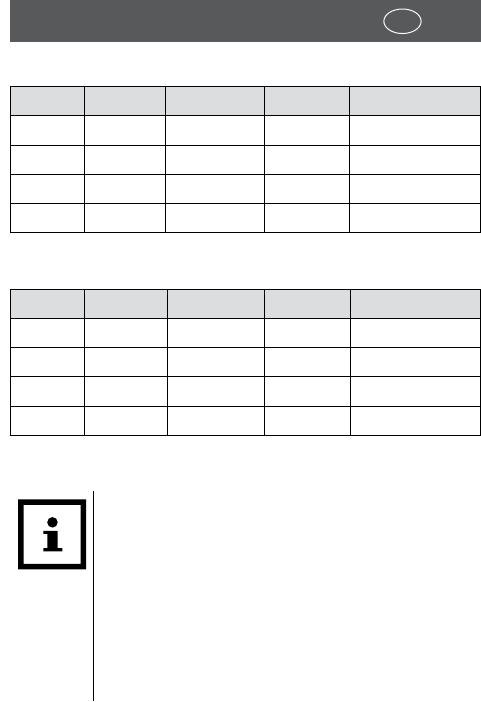
71
USA
Evaluación de resultados
Valores de grasa corporal para mujeres
Edad Bajo Normal Alto Muy alto
10–29 <23 23–34 35–45 >45
30–59 <23 23–34 35–45 >45
60–69 <23 23–34 35–45 >45
>70 <23 23–37 38–45 >45
Valores de grasa corporal para hombres
Edad Bajo Normal Alto Muy alto
10–29 <11 11–24 25–35 >35
30–59 <13 13–25 26–35 >35
60–69 <12 12–25 26–35 >35
>70 <12 12–29 30–35 >35
Porcentaje de agua corporal
¡AVISO!
Los resultados de medición de la balanza
no permiten sacar ninguna conclusión
médicamente sólida sobre retención de
agua como consecuencia de la edad. Si
los porcentajes de agua corporal medidos
le preocuparan, hable con su médico al
respecto.

72 USA Evaluación de resultados
El porcentaje de agua corporal es directamente
proporcional al porcentaje de grasa corporal y masa
muscular. La grasa corporal contiene un nivel de agua
relativamente bajo, al contrario que los músculos, cuyo
nivel de agua es relativamente alto.
Por tanto, las personas con bajo porcentaje de grasa
corporal y alto porcentaje de masa muscular pueden
lograr porcentajes de agua corporal superiores a
los valores orientativos (por ejemplo, deportistas de
resistencia).
Por el contrario, con frecuencia, el porcentaje de agua
corporal en personas con alto porcentaje de grasa
corporal es inferior a los valores orientativos.
En principio es deseable un alto porcentaje de agua
corporal.
Las tablas siguientes muestran una vista general de valores
orientativos para porcentajes de agua corporal (%).
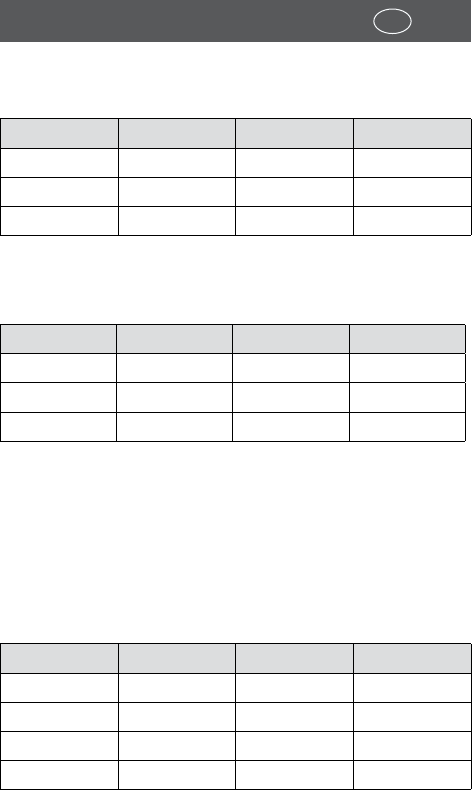
73
USA
Evaluación de resultados
Valores de porcentaje de agua corporal para
mujeres
Edad Bajo Normal Alto
10–29 <52 52–72 >72
30–49 <40 40–60 >60
>50 <45 45–65 >65
Valores de porcentaje de agua corporal para
hombres
Edad Bajo Normal Alto
10–29 <55 55–75 >75
30–49 <50 50–70 >70
>50 <48 48–68 >68
Porcentaje de masa muscular
Las tablas siguientes muestran una vista general de valores
orientativos para porcentajes de masa muscular (%).
Valores de porcentaje de masa muscular para
mujeres
Edad Bajo Normal Alto
10–29 <35 35–45 % >45
30–59 <28 28–40 % >40
60–69 <23 23–35 % >35
>70 <23 23–30 % >30
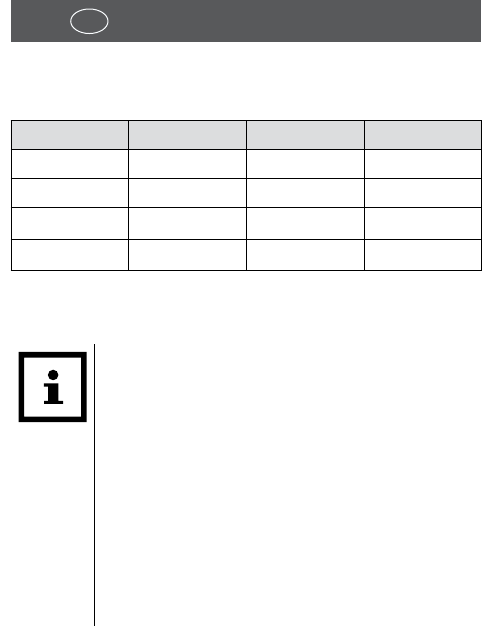
74 USA Evaluación de resultados
Valores de porcentaje de masa muscular para
hombres
Edad Bajo Normal Alto
10–29 <40 40–50 % >50
30–59 <33 33–45 % >45
60–69 <32 32–40 % >40
>70 <30 30–35 % >35
Masa ósea
¡AVISO!
La balanza mide el peso de todas las partes
óseas en libras. Esto no es lo mismo que el
contenido de calcio o la densidad ósea. Las
mediciones del contenido de calcio y de
la densidad ósea sólo pueden realizarse
por un médico especialista con un aparato
médico especial. Por tanto, la masa ósea no
revela nada sobre cambios en los huesos
o dureza de los mismos, o enfermedades,
como p. ej. osteoporosis.
El esqueleto se altera durante el transcurso de la vida.
En adolescentes, la masa ósea crece rápidamente
y alcanza su punto máximo entre los 30 y 40 años.
A continuación, la masa ósea vuelve a reducirse
ligeramente.

75
USA
Evaluación de resultados
La masa ósea depende del sexo, tamaño, edad y peso,
y sólo puede influirse ligeramente. Por tanto, tampoco
existen valores orientativos generalmente válidos.
La pérdida de masa ósea asociada con la edad puede
contrarrestarla mediante su alimentación y actividad
física. Para ello, procure una ingesta adecuada de
vitamina D y calcio. También puede fortalecer su
esqueleto practicando un deporte específico para
desarrollar su musculatura.
Consumo de calorías en reposo (BMR)
El consumo de calorías en reposo o la tasa metabólica
básica (BMR) hace referencia a la cantidad de energía
que un cuerpo necesita diariamente en estado de
reposo absoluto para mantener sus funciones básicas.
Por tanto, usted tiene que absorber al menos esa
cantidad de energía con su alimentación para evitar
daños en la salud.
Los principales factores que influyen en la tasa
metabólica básica son la altura, la edad y el peso.
La balanza calcula este valor en kilocalorías por día
(kcal/24h) mediante la fórmula de Harris-Benedict.

76 USA Evaluación de resultados
Consumo de calorías en la vida
cotidiana (AMR)
El consumo de calorías en la vida cotidiana o tasa
metabólica activa (AMR) hace referencia a la cantidad
de energía que un cuerpo consume diariamente con
actividad. La balanza calcula esta cantidad en kilocalorías
por día (kcal/24h).
Para mantener su peso, usted tiene que absorber con su
alimentación la cantidad de energía que se corresponda
con la tasa metabólica activa. Si absorbe menos de
energía que la tasa metabólica activa calculada, perderá
peso.
Por el contrario, su peso aumenta si absorbe más energía
que la tasa metabólica activa. No obstante, sin actividad
física adicional, como deporte, el aumento del suministro
de energía sólo origina el incremento del
porcentaje de
grasa corporal.
La tasa metabólica activa está influenciada
principalmente por el grado personal de actividad.
Como parámetro de cálculo, la balanza utiliza grados de
actividad en cinco escalonamientos.
En el capítulo “Ajuste del grado de actividad” puede
encontrar información detallada sobre los grados de
actividad.

77
USA
Evaluación de resultados
Valores de medición en relación con
otros valores
¡AVISO!
La suma de los valores del porcentaje de
agua, grasa y músculos no tiene sentido,
pues los músculos contienen partes del
agua.
Generalmente, sólo son realmente significativos los
cambios a largo plazo en los valores de medición.
Por otra parte, los resultados individuales han de
contemplarse en relación con otros. De ello se derivan
tres aspectos básicos:
• Cambio del peso total,
• Cambio de los porcentajes de grasa y agua corporal
y masa muscular,
• Periodo en que se producen dichos cambios.
Los periodos se diferencian en:
A corto plazo Cambio en días
A medio
plazo
Cambios en semanas
Largo plazo Cambios en meses
Las fluctuaciones de peso a corto plazo se deben casi
exclusivamente a cambios en el porcentaje de agua,
pues los porcentajes de grasa y músculos sólo cambian
a medio o largo plazo.

78 USA Evaluación de resultados
Las pérdidas de peso a corto plazo con aumento del
porcentaje de grasa corporal también hacen referencia
a una pura pérdida de agua. La causa podría ser p.
ej. dietas orientadas a una pérdida de peso rápida, o
entrenamientos deportivos sin compensación adecuada
de líquidos.
A ser posible, sustente sus dietas con actividad física,
como p. ej. entrenamiento de fitness o fuerza, para
aumentar su porcentaje de masa muscular.
El aumento de peso a medio plazo con porcentaje de
grasa corporal constante o decreciente hace referencia
a un incremento de músculos.
Si el peso y el porcentaje de grasa corporal se reducen,
o el porcentaje de masa muscular aumenta, ello
hace referencia a una dieta que funciona o a un
entrenamiento adecuado.
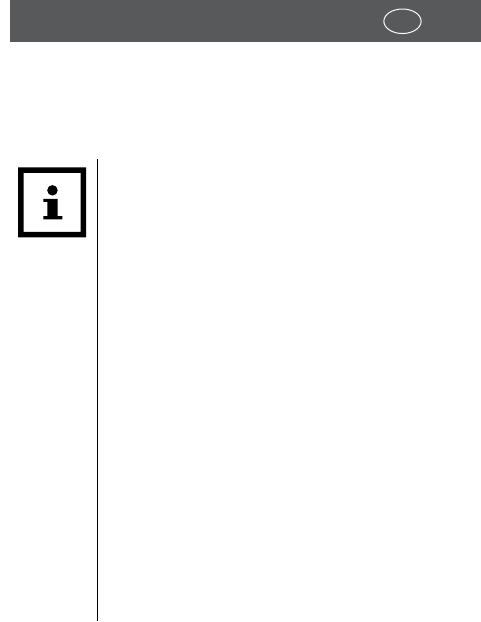
79Limpieza y mantenimiento USA
Limpieza y mantenimiento
Limpieza
¡AVISO!
¡Riesgo de daños materiales!
Si limpia la balanza de forma
inadecuada, la misma puede sufrir
daños.
− No utilice productos de
limpieza o disolventes
agresivos.
− No utilice cepillos con cerdas
de nylon o alambre, ni
objetos de limpieza afilados
o metálicos, como cuchillos,
espátulas duras y similares.
− No introduzca la balanza en
el lavavajillas, pues podría
provocarle desperfectos.
− Para la limpieza, utilice un paño humedecido con
agua. En caso necesario puede utilizar un poco de
detergente o una lejía jabonosa suave.
− Tras la limpieza, seque la balanza con un paño suave.

80 Limpieza y mantenimiento
USA
Cambio de pilas
Si se coloca sobre la balanza y en el display aparece la
indicación “Lo” en lugar de valores de medición, las pilas
ya no suministran la corriente necesaria.
Si se coloca sobre la balanza y el display no indica nada,
las pilas estarán descargadas. Para cambiar las pilas,
proceda de la siguiente forma:
1. Coloque la balanza sobre una base suave con la parte
superior hacia abajo.
2. Abra el compartimento de pilas 4 (véase la fig.B).
3. Saque las pilas 3 del compartimento de pilas.
4. Inserte pilas nuevas en el compartimento de pilas.
Utilice pilas del mismo tipo.
La polaridad es correcta si los polos negativos
de las pilas tocan los contactos de muelle del
compartimento de pilas.
5. Cierre el compartimento de pilas.
6. Voltee la balanza.
En el display aparece la indicación “0.0”.
7. Si el display no indica nada, retire las pilas y vuelva a
colocarlas.
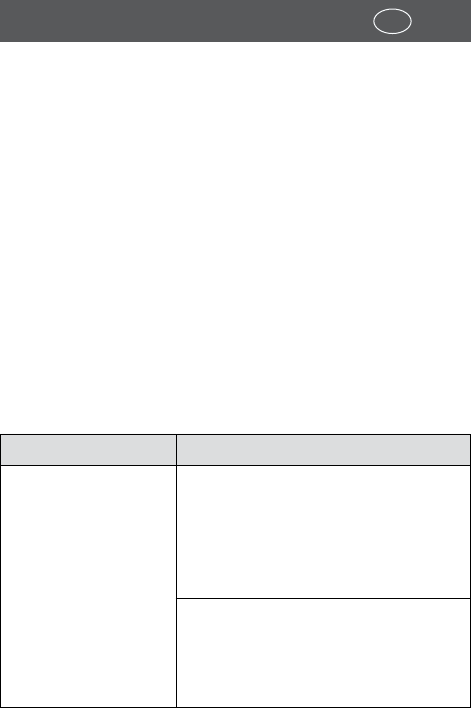
81Almacenamiento USA
Almacenamiento
Si no desea utilizar la balanza durante un periodo de
tiempo prolongado, respete las siguientes indicaciones:
− Saque las pilas del compartimento de pilas.
− No guarde la balanza cerca de fuentes de calor.
− No coloque objetos pesados sobre la balanza si no la
utiliza.
Búsqueda de fallos
Si se produjera un funcionamiento erróneo, antes de
enviar la balanza para su reparación, verifique primero
los puntos siguientes.
Problema Causas y soluciones
El display no indica
nada.
Las pilas no se han insertado
correctamente.
− Extraiga las pilas e insértelas
de nuevo. Al hacerlo, controle
la polaridad correcta.
Las pilas están descargadas.
− Sustituya las pilas
descargadas por unas
nuevas.
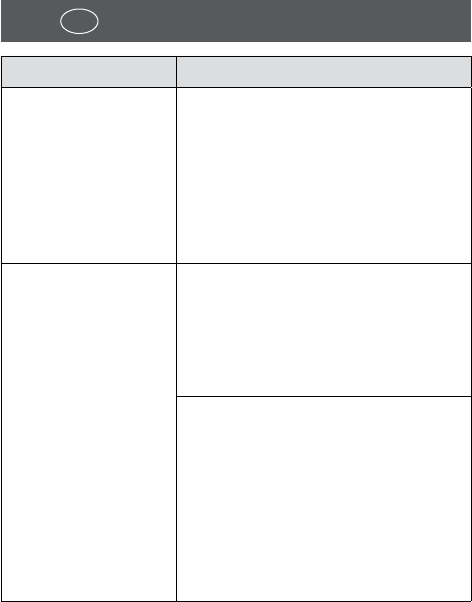
82 Búsqueda de fallos
USA
Problema Causas y soluciones
El display indica
“Lo” en lugar
de valores de
medición, y
la balanza se
desconecta de
inmediato.
Las pilas ya no suministran la
corriente necesaria.
− Sustituya las pilas por unas
nuevas.
El display indica
“Err” en lugar
de valores de
medición.
Se ha superado el límite superior
del rango de medición (396 lbs).
− La balanza sólo ha de
cargarse con 396 lbs como
máximo.
Durante las mediciones no
se ha quedado quieto o su
peso corporal no se distribuye
uniformemente en ambos pies.
− Quédese quieto durante
las mediciones y disponga
su peso uniformemente en
ambos pies.

83Búsqueda de fallos USA
Problema Causas y soluciones
Sólo se indica el
peso.
No ha realizado la medición
descalzo, las plantas de sus pies
están demasiado secas o tiene
demasiada callosidad en las
mismas.
− Repita la medición descalzo.
− En caso necesario,
humedezca ligeramente las
plantas de sus pies.
− Elimine la callosidad de las
plantas de sus pies.
El porcentaje de
grasa está fuera
del rango medible
(< 5 % o > 50 %).
En mediciones de
peso, la balanza
no empieza con
cero.
La balanza se ha ajustado
erróneamente.
− Espere hasta que la
balanza se desconecte
automáticamente.
− Colóquese de nuevo sobre
la balanza y espere hasta
que en el display aparezca la
indicación “0.0”.
− Repita su medición.
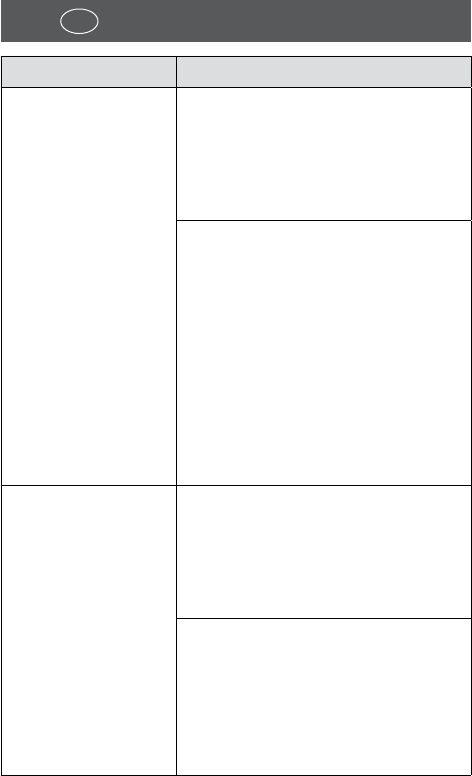
84 Búsqueda de fallos
USA
Problema Causas y soluciones
Entre su
smartphone o
tablet y la balanza
no se establece
ninguna
conexión ni
después de
transcurrir aprox.
180 segundos.
La función Bluetooth® está
desconectada en su smartphone
o tablet.
− Conecte la función Bluetooth®
en su smartphone o tablet.
El receptor Bluetooth® de
la balanza no funciona
correctamente.
− Saque las pilas del
compartimento de pilas.
− Coloque las pilas de nuevo.
− Desconecte y vuelva
a conectar la función
Bluetooth®
en su smartphone o tablet.
Entre su
smartphone o
tablet y la balanza
no se establece
ninguna
conexión ni
después de
transcurrir aprox.
180 segundos.
Su smartphone o tablet no
funcionan correctamente.
− Desconecte su smartphone o
tablet totalmente y vuelva a
conectarlos.
La instalación de la aplicación
en su smartphone o tablet no ha
sido exitosa.
− Reinstale la aplicación e
inicie sesión con sus datos de
usuario.
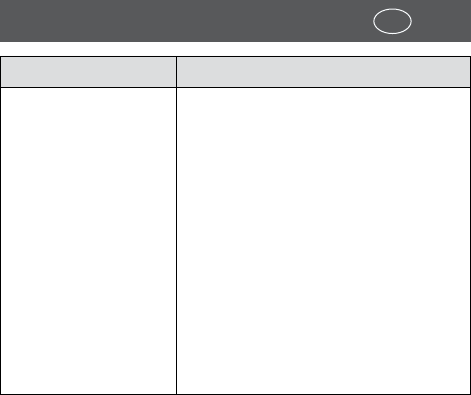
85Búsqueda de fallos USA
Problema Causas y soluciones
Los datos de
medición
guardados no se
transmiten en su
totalidad.
Usted ha realizado más de 30
mediciones sin conexión con la
aplicación.
Tras la creación de un usuario,
la balanza puede guardar 30
mediciones en total.
A continuación, el display indica
“FULL”.
− Conecte la balanza
regularmente con la
aplicación para que no pierda
datos de medición.
Como ayuda adicional para su balanza, coteje
las FAQ (frequently asked questions = preguntas
más frecuentes) en el sitio web siguiente:
www.cranesportsconnect.com/faq.
Si las medidas mencionadas no deparan el resultado
deseado, contacte con nuestro servicio técnico. Para
ello, utilice la siguiente información y respete también el
capítulo “Garantía“.
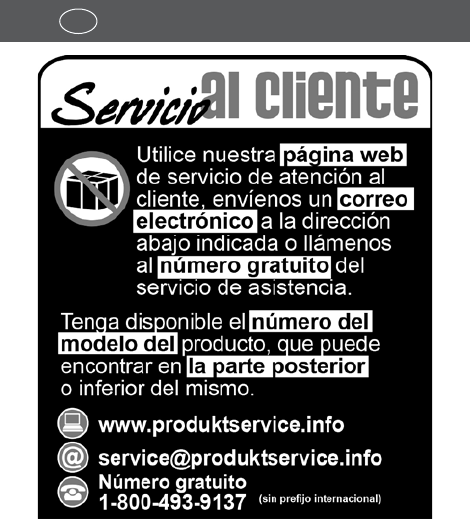
86 Búsqueda de fallos
USA

87Datos técnicos USA
Datos técnicos
Tipo: AU5-CDSC-1
Número de artículo: 92125
Alimentación de corriente: pilas 3 x 1,5 V DC,
tipo LR03/R03/AAA
Materiales
Superficie de balanza: vidrio de seguridad, grosor
de 6 mm
Electrodos: acero inoxidable
Carcasa: plástico ABS
Dimensiones (An x Pr x Al): 11.9 x 11.8 x 0.9 “
(30 x 30 x 2.3 cm)
Límite superior de rango
de medición:
180 kg / 396 lb / 28 st
Límite inferior de rango
de medición:
3 kg / 6.6 lb / 0 st (≈ 6.6 lb)
Precisión de indicación
Peso: 0.1 kg / 0.2 lb / 0.2 lb
Masa ósea: 0.1 kg / 0.2 lb / 0.2 lb
Porcentaje de grasa
corporal:
0.1 %
Porcentaje de agua
corporal:
0.1 %
Porcentaje de masa
muscular:
0.1 %
Demanda de calorías: 1 kcal

88 Declaración de conformidad
USA
Declaración de conformidad
Este dispositivo cumple con el apartado 15 de
las normas de la FCC (Federal Communications
Commission – Comisión Federal de Comunicaciones).
El funcionamiento está sujeto a las dos condiciones
siguientes: (1) este dispositivo puede no provocar
interferencias perjudiciales, y (2) este dispositivo tiene
que aceptar cualquier interferencia recibida, incluyendo
interferencias que puedan provocar un funcionamiento
no deseado.
INDICACIÓN: Este equipo ha sido comprobado y
cumple con las limitaciones aplicables a un dispositivo
digital clase B, de acuerdo con el apartado 15 de las
normas de la FFC. Esas limitaciones están diseñadas
para proporcionar una protección razonable contra
interferencias perjudiciales en una instalación
residencial. Este equipo genera, usa y puede irradiar
energía de radiofrecuencia, y si no se instala y utiliza
de acuerdo con las instrucciones, puede provocar
interferencias perjudiciales en comunicaciones de
radio. Sin embargo, no se garantiza la ausencia de
interferencias en una instalación particular. Si este
equipo no provoca interferencias perjudiciales en la
recepción de señales de radio o televisión, lo cual puede
determinarse apagando y encendiendo el equipo, se
anima al usuario a que intente corregir la interferencia
mediante una o varias de las siguientes medidas:
• Reorientar o reubicar la antena receptora.
• Aumentar la separación entre el equipo y el receptor.

89Declaración de conformidad USA
• Consultar al distribuidor o a un técnico experto en
radio/televisión para obtener ayuda.
• Conectar el equipo en un toma de corriente de un
circuito distinto del circuito donde está conectado el
receptor.
ATENCIÓN: Los cambios o modificaciones en esta unidad que
no estén autorizados expresamente por la parte responsable
del cumplimiento podrían anular el permiso del usuario para
manejar el equipo.

90 Eliminación
USA
Eliminación
Eliminación del embalaje
− Elimine el embalaje por tipos de material. El
cartón y las láminas han de llevarse a un punto de
recogida de papel usado y un punto de recogida de
materiales respectivamente.
Eliminación de la balanza con
diagnóstico
− Elimine la balanza con diagnóstico de acuerdo con las
disposiciones y leyes vigentes en su país.
¡Las pilas y los acumuladores no deben tirarse a la
basura doméstica!
Como consumidor, usted está obligado legalmente
a llevar todas las pilas y acumuladores –
independientemente de que contengan sustancias
nocivas* o no – a un punto de recogida de su
comunidad/barrio, o a la tienda, para que puedan
eliminarse de forma respetuosa con el medio ambiente.
¡Las pilas y los acumuladores sólo deben llevarse a un
punto de recogida cuando estén descargadas!
* señalados con: Cd = cadmio, Hg = mercurio, Pb = plomo
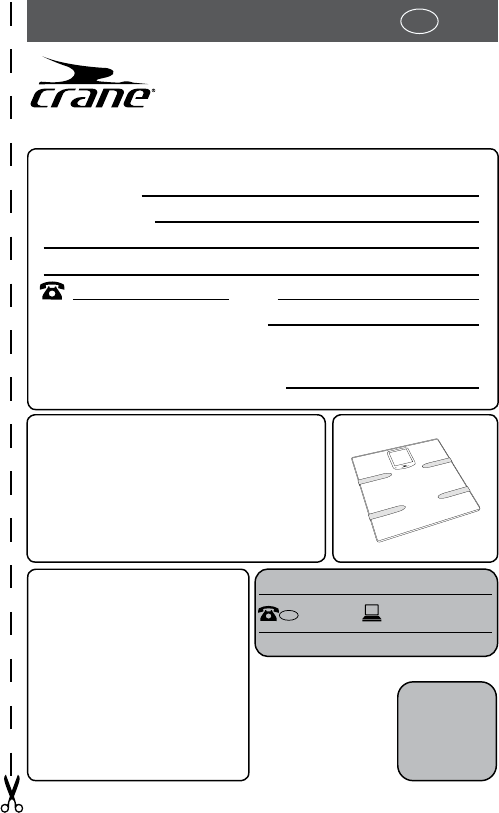
91
USA
Warranty/Garantía
WARRANTY CARD
BLUETOOTH® DIAGNOSTIC SCALE
TARJETA DE GARANTÍA
Your details / Sus detalles:
Name / Nombre
Address / Dirección
E-mail
Date of purchase / Fecha de compra*
* We recommend you keep the receipt with this warranty card. / Recomendamos
guardar el recibo junto con esta tarjeta de garantía.
Location of purchase / Lugar de compra
BALANZA CON DIAGNÓSTICO POR BLUETOOTH®
Description of malfunction / Descripción del
defecto:
Return your completed warranty card
together with the faulty product to: /
Envíe la tarjeta de garantía rellenada
junto con el producto defectuoso a:
Krippl-Watches
c/o ShipmyOrders
2567 W. Cheyenne Ave
North Las Vegas, NV 89032
USA
Hotline:
toll-free
YEAR WARRANTY
3
AÑO DE GARANTÍA
AFTER SALES SUPPORT • SERVICIO DE POSTVENTA
service@produktservice.info
Model: AU5-CDSC-1 Product code: 92125 04/2015
+1 800 493 9137
USA
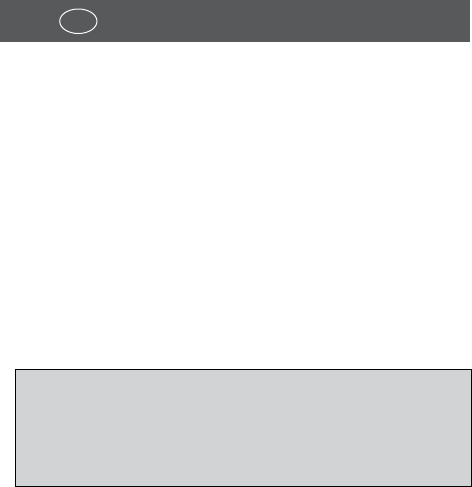
92 USA
Warranty conditions
Dear Customer,
The ALDI warranty offers you extensive benefits compa-
red to the statutory obligation arising from a warranty:
Warranty period:3 years from date of purchase.
6 months for wear parts and consu-
mables under normal and proper
conditions of use (e.g. rechargeable
batteries).
Costs: Free repair/exchange or refund.
No transport costs.
ADVICE: Please contact our service hotline by
phone, e-mail or fax before sending
in the device. This allows us to provide
support in the event of possible oper-
ator errors.
In order to make a claim under the warranty, please
send us:
• together with the faulty item the original receipt
and the warranty card properly completed.
• the faulty product with all components included
in the packaging.
Warranty

93
USA
Warranty
The warranty does not cover damage caused by:
• Accident or unanticipated events
(e.g. lightning, water, fire).
• Improper use or transport.
• Disregard of the safety and maintenance
instructions.
• Other improper treatment or modification.
After the expiry of the warranty period, you still have the pos-
sibility to have your product repaired at your own expense. It
the repair or the estimate of costs is not free of charge you will
be informed accordingly in advance.
This warranty does not limit the statutory obligation of the
seller arising from a warranty. The period of warranty can only
be extended in accordance with a legal standard. In countries
where a (compulsory) warranty and/or spare part storage
and/or a system for compensation are/is required by law, the
statutory minimum conditions apply. In the event that a pro-
duct is received for repair, neither the service company nor
the seller will assume any liability for data or settings possibly
stored on the product by the customer.

94 USA
Condiciones de garantía
Estimado cliente:
La garantía de ALDI le ofrece amplias ventajas en com-
paración a la obligación legal a la que está sujeta una
garantía:
Periodo de
garantía:
3 años a partir de la fecha de compra.
6 meses para piezas de desgaste y
consumibles bajo condiciones normales
y reglamentarias de uso (p. ej. baterías
recargables).
Costes: Reparación/sustitución gratuita a reem-
bolso.
Sin costes de transporte.
Aviso: Rogamos póngase en contacto con su
servicio de asistencia directa por teléfono,
e-mail o fax antes de enviar al aparato.
Esto nos permitirá ofrecerle soporte en
caso de posibles errores de operador.
A fin de reclamar en el marco de la garantía,
rogamos nos envie:
• junto con el producto defectuoso el tiquet
de caja original y la tarjeta de garantía
completamente rellenada.
• el producto defectuoso con todos los
componentes incluidos en el volumen de
suministro.
Garantía

95
USA
Garantía
La garantía no cubre daños causados por:
• Accidente o sucesos imprevistos (p. ej.
rayos, agua, fuego).
• Uso o transporte inadecuados.
• Inobservancia de las instrucciones de
seguridad y mantenimiento.
• Otro tipo de manejo o modificación
inadecuado.
Una vez expirado el periodo de garantía, usted seguirá teni-
endo la posibilidad de reparar su aparato a cargo propio. Si la
reparación o la estimación de costes no es gratuita, se le infor-
mará correspondientemente y por adelantado.
Esta garantía no limita la obligación legal del vendedor ori-
ginada por una garantía. El periodo de garantía solamente
se podrá alargar conforme a las normas legales. En los países
en que la ley exija una garantía (obligatoria) y/o el almacena-
miento de piezas de recambio y/o un sistema de compensa-
ción, serán de aplicación las condiciones legales mínimas.
Al recibir un producto para su reparación, ni la compañía de
servicios ni el vendedor asumirán responsabilidad alguna por
los datos o los ajustes que el cliente haya podido almacenar en
el producto.
